In September 2005 I took a private charter in a Cessna 206 from Nairobi to the Masai Mara game reserve in Kenya with Paveena and some friends. During the flight I got talking to the pilot and having established that I was a keen photographer, he asked me if I would be interested in taking some aerial photographs. While I had always marveled at the African landscape as seen from the air especially when flying low, as one often does in smaller, charted planes, it wasn’t something I had ever given much thought to. When he told me it would be possible to remove both doors at the back right hand side of the aircraft, providing an expansive and flexible view from the plane, I was intrigued.
The next year I returned with Paveena for my first aerial excursion – to the surreal geological formations that constitute Lake Natron, straddling the border between Kenya and Tanzania. As we approached the lake, I was dumbfounded to find a vast, blood-red lake bed, covered with just a few inches of water. Strange mineral deposits dotted the lake, forming mini, atoll reef-like structures. To cap it off, there were hundreds of thousands of Flamingos feeding in the shallow waters with others flying in V-shaped, squadron formations. As they cruised low over the surface waters, the sun cast dark shadows on the mirror-like lake surface with perfect accompanying Flamingo and cloud reflections. The shadows bore a striking resemblance to Pterodactyles and at times I felt as if I had been transported back in time or even to the surface of a distant planet. I can honestly say that for me, it was a life changing experience and aerial photography in East Africa has since become a near decade long addiction.
Since that first expedition, I have made at least one aerial trip in Kenya each year. In the process I have discovered, explored and been overwhelmed by Kenya’s divergent landscapes but it is its soda lakes that I keep coming back to and it is in the far north and south of the country that these are at their most superlative. It took me a long time to start making decent images from the aircraft. One day I will get up in a helicopter, but the cost of doing so remains prohibitive. Compared to a helicopter with its ability to fly at slow speeds and most importantly, hover, photographing from the open doors of a fast flying plane is altogether more challenging. Initially there is the fear factor with only a thin, loosely fastened seat belt (it has to be loose in order for you to turn your body) preventing you from falling out of the plane to a certain death. Turbulence is almost ever present. The plane jerks up and down often making any sort of framing with a camera impossible. An overhead wing, a protruding right-hand side wheel and a tail wing mean that the widest one can shoot without including these elements, is about 25mm. Wind rushes past the fuselage at hurricane force rates, making it unfeasable to extend one’s lenses out the open doors. Forget about lens hoods. Over time I have developed various techniques to use my body as a wind shield to at least partially circumvent this problem. This type of aerial photography is not recommended for those that suffer from motion sickness. I’ve had more than one accompanying friend whose last meal has ended up in the sick-bag. Most of all you need highly skilled pilots. Flying with the doors removed has been described to me by my pilots as akin to driving a car with the hand brake partly engaged. Wind shear in the far north of Kenya can be extreme and for a light aircraft, potentially fatal. I would be lying if I denied that my heart has not felt it was in my throat a few times as we have approached a dusty airstrip with the plane careering erratically and seemingly destined for a catastrophic ending. But my trust in their abilities is 100% and all my excursion have been incident free; so a big shout out to Peter and Christian.
From a photographic perspective, you need to consider the sun’s orientation. There’s no point flying north in the morning as you’ll have the sun in your face if you are shooting out the right side of the plane. The biggest issue however, is simply that the aircraft travels fast and the closer to the ground, the greater the apparent speed. With experience I have found that you need to be in a state of high alert at all times. You have to be constantly looking forward with your head very slightly out the door (yes, this will feel like you have placed your head into a scientifically generated wind tunnel) carefully scanning ahead and below for upcoming features and action. When you spot something, you have literally a few seconds to a) decide on which camera/lens combination you will use; b) dial in the appropriate level of exposure compensation and c) frame and compose the image. I can assure you, this is not easy. While there are lots of occasions for working in manual exposure, this is not one of them. Trust me on this. If one second you are photographing light or even white coloured sodium formations and the next, white and pink winged flamingos over a medium coloured background, it is far easier to work in AV and use your thumb to dial in compensation (in this case from around +1 and 2/3 to -1 and 2/3, or ten clicks of the wheel). At the soda lakes, where one is typically flying in circular patterns, the sun’s orientation to the aircraft is constantly changing (unless at noon), again obviating the use of manual exposure. Since the very first flight, I have used two camera bodies, secured these days around my neck by Black Rapid camera straps, and typically comprising a full frame camera body with a 24-105mm IS lens and then a cropped sensor camera with a 70-200mm IS lens, sometime in use with a 1.4x converter. For the first lens, you’ll need shutter speeds of at least 1,000th sec. For the second lens, at least 2,000th sec. You can shoot with very large apertures (eg. f4) as depth of field is not an issue when shooting from the air at large distances. There is usually plenty of light meaning that most of the time you can shoot at ISOs of 400 to 500 and still have plenty of shutter speed. If it is cloudy, then you might have to go up to 800-1,000 but with today’s cameras, this is not an issue. Occasionally on the wider lens I will use a circular polarizer.
Like any subject that one photographs regularly, you start to develop an interest in it. For the soda lakes and the Flamingos, it wasn’t long before I was asking basic questions such as: how did the soda lakes form? what are they composed of? what are the strange lake bed colours and geological patterns that I was seeing? why were these patterns, formations and colours ever changing? why did the flamingos have the lakes pretty much to themselves? etc. While my knowledge is far from complete, over time I have build up a rudimentary understanding of the soda lake environment and its primary inhabitant.
I don’t want to bore you with a long winded account so I will try to summarise things briefly and clearly. East Africa’s soda lakes lie within the Great Rift Valley, a fault line that stretches over 6,000 kms from Lebanon to Mozambique and which has formed a vast valley in which numerous lakes, escarpments and volcanoes exist. The soda lakes were formed at a time when the valley floor was covered in volcanic ash, heavily composed of sodium carbonate. Rain water carried this chemical and other mineral salts into rivers which in turn flowed into the newly formed lakes. The lakes had no outlet source and with oven-like temperatures around many of the lakes, the dissolved minerals accumulated and were concentrated through evaporation. This produced various sodium and phosphate compounds, the most important of which were sodium bicarbonate and sodium hydroxide. It is these compounds that give the lakes their high alkaline content and when concentrated in the extreme, can result in waters that are highly corrosive to human flesh.
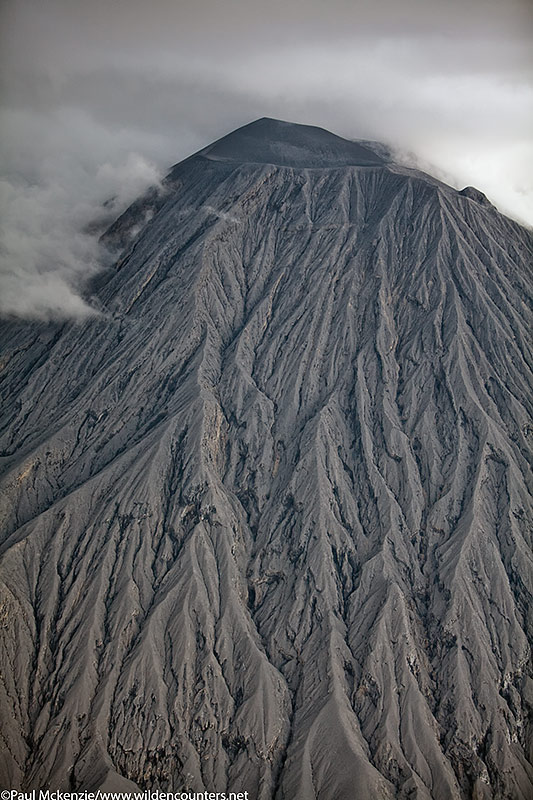
Aerial image of Ol Doinyo Lengai volcano, Tanzania. This is an active volcano on the south east shore of Lake Natron. On contact with rain or moisture in the air, the lava is transformed into sodium carbonate. Much of this ends up being transported by rain water flowing down the heavily eroded sides into the lake helping to give the waters their unique alkaline characteristics.
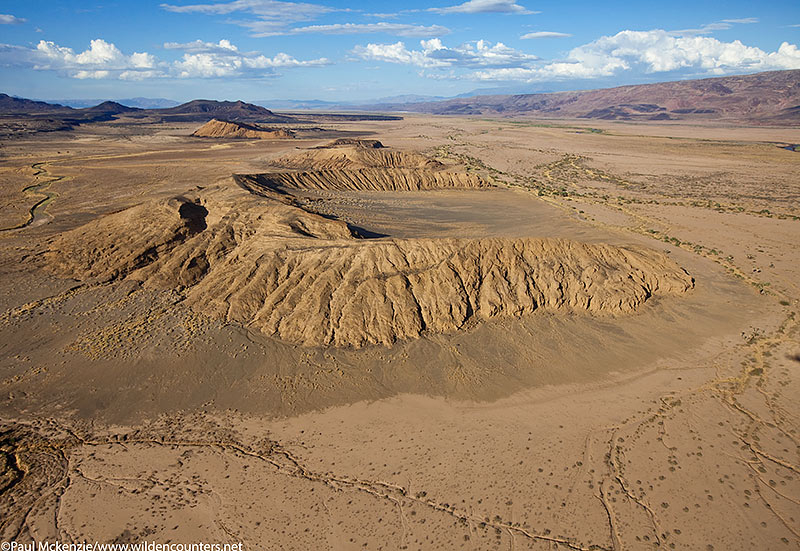
Ancient volcanic calderas, Seguta Valley, Northern Kenya. The Seguta Valley was once part of Lake Turkana but is now separated by a formidable volcanic ridge. Evidence of historic volcanic activity is ever present along the entire valley. It is inaccessible by vehicle and few humans are ever likely to have traversed the parched lands. It truly feels like the land that time forgot.
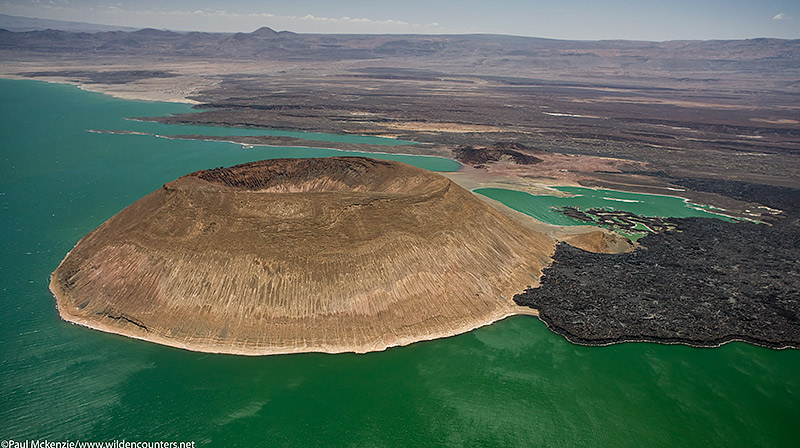
The caldera of Nabuyatom volcano on the southern shore of Lake Turkana, Northern Kenya. This is a spectacular, uneroded caldera flanked by black lava. Lake Turkana is often referred to as the “Jade Sea” for the dazzling green shades that its waters take on in the mid-day sun.
At sunset, Turkana’s waters can take on altogether different colours. In this next image, wind blowing across the lake surface has imparted a textile-like quality to the waters.
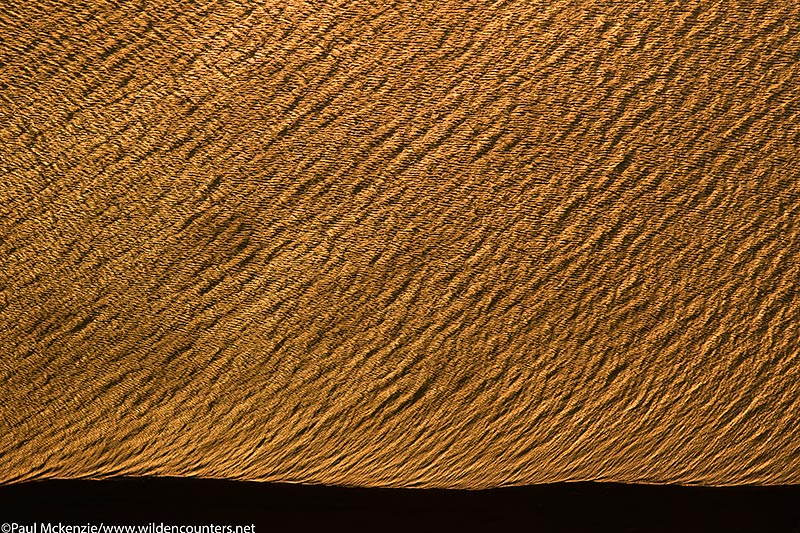
Aerial image of lake water patterns at sunset on the shore of Lake Turkana, Kenya
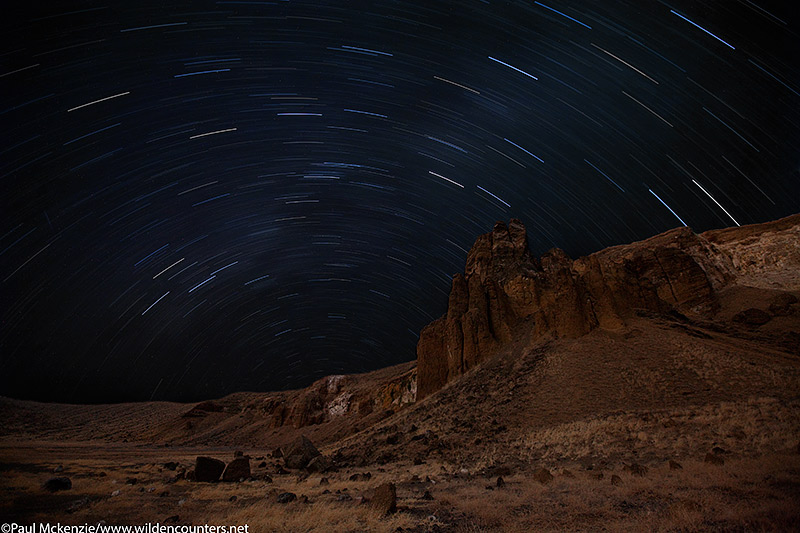
Star trails over crater walls, two exposures blended together, Central Island, Lake Turkana, Kenya
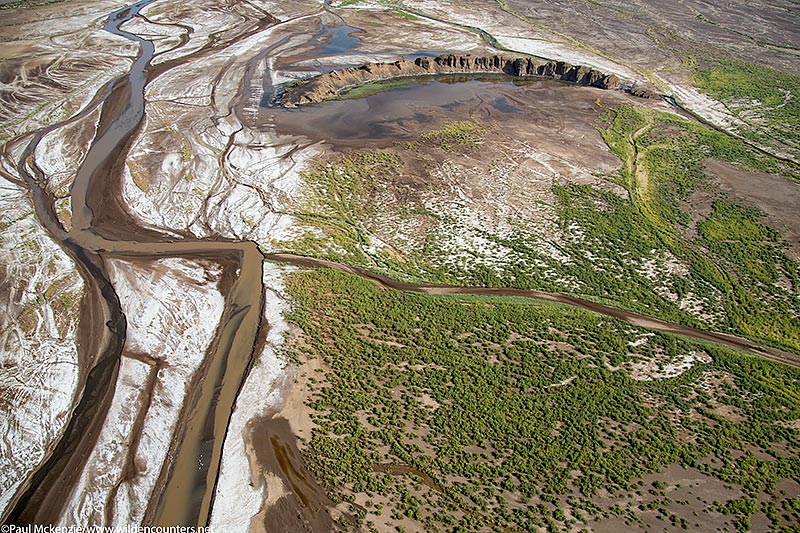
Aerial image of the Seguta River and the ancient remains of an eroded caldera, Seguta Valley, Kenya. The Seguta River winds its way up the Seguta valley, snaking past numerous volcanic features and terminates in an alluvial delta at the southern shore of Lake Logipi. The river is often dry for parts of the year but here it is full and the surrounding vegetation indicates recent rains.
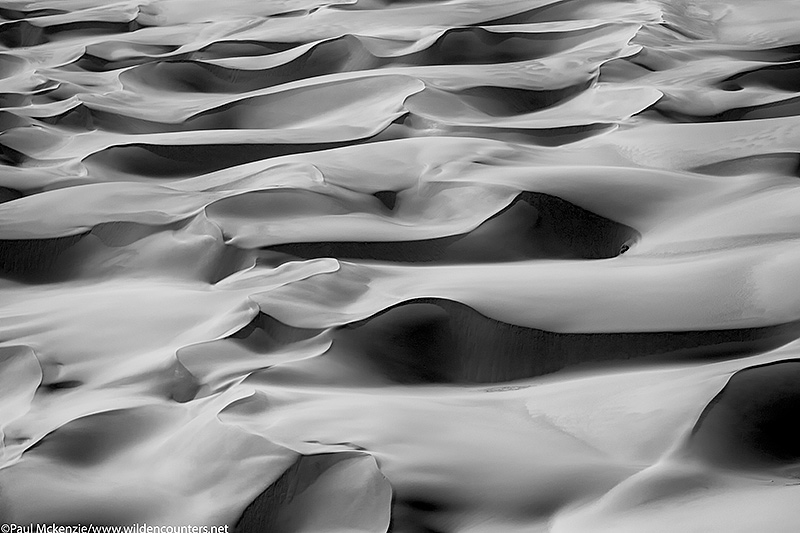
Aerial view of sand dunes in the Seguta Velley, Kenya. Despite the river, parts of the Seguta Valley are so dry that small areas of beautiful sand dunes have formed.
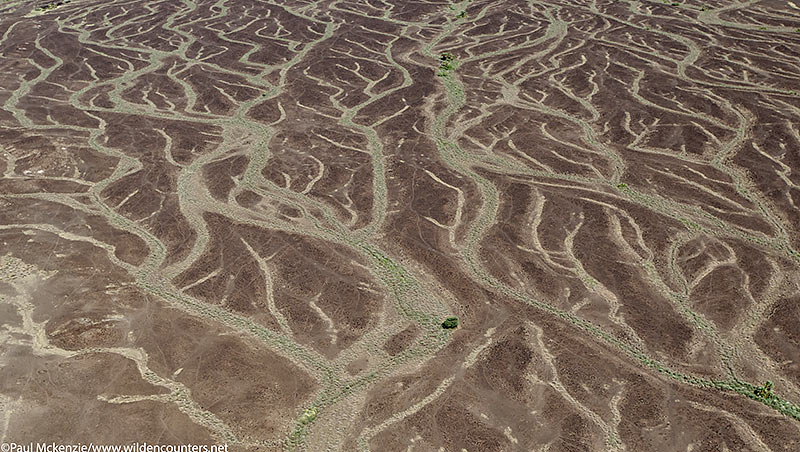
Rain erosion patterns, Seguta Valley, Kenya. This image was taken less than 10 kms from the sand dunes and highlights the diversity of landscapes that can be found in the valley.
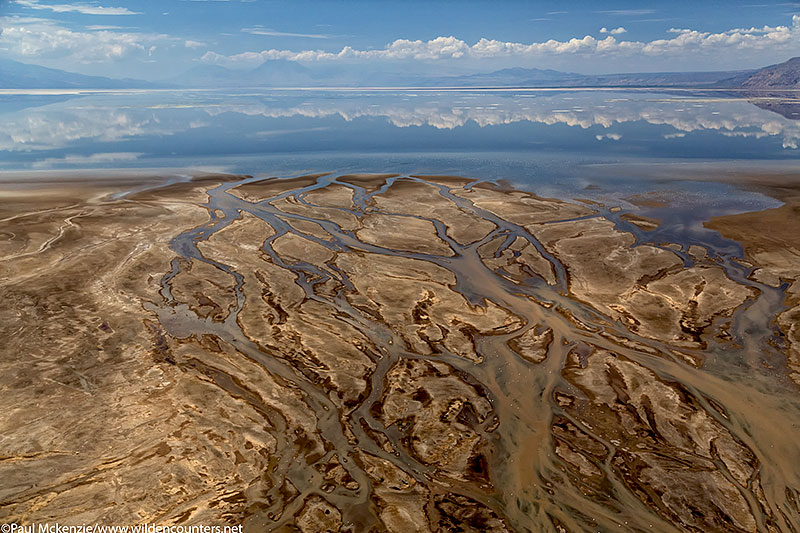
This is the delta formed by the Southern Ewaso Ng’iro River as it drains into Lake Natron. The lake water at this end marks the border between Kenya and Tanzania
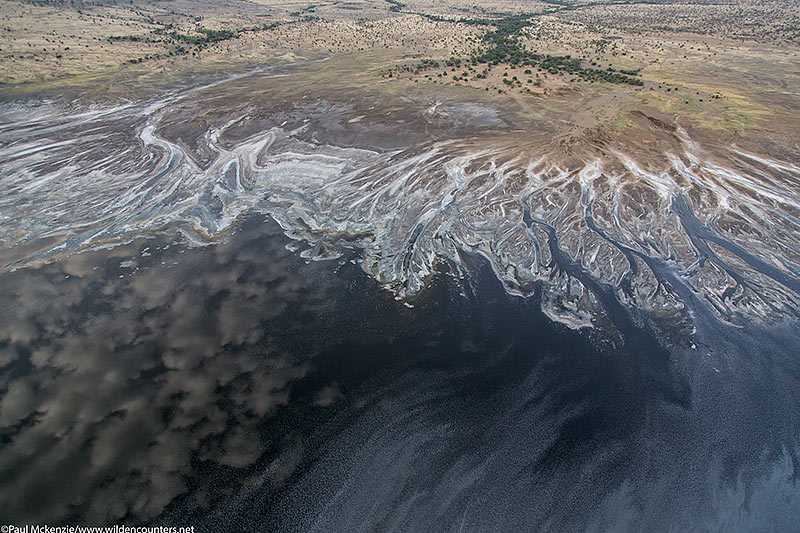
Aerial view of the same river delta on Lake Natron shot from the other direction. Evaporation has caused sodium compounds to form on the delta shore while evaporated sodium trails are evident on the lake surface. Cloud reflections can be seen on the lower left.
The mineral concentrations vary from lake to lake and rainfall patterns and temperatures are other catalysts. With furnace-like temperatures, evaporation rates can be extreme and some of the lakes look dramatically different from month to month depending on rainfall patterns. Lake Natron and Logipi are prime examples of this. The following three images show Cathedral Rock, a volcanic structure that sits within the northern reaches of Lake Logipi. Each was taken on a different occasion over the course of 18 months.
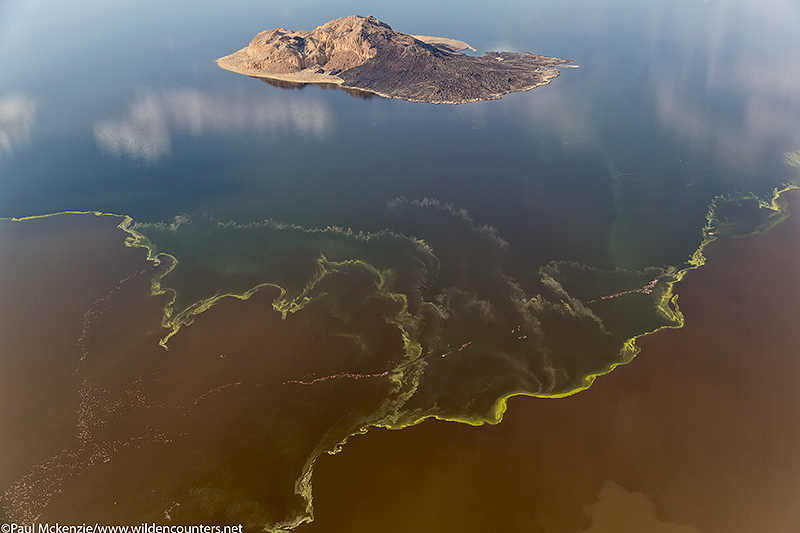
High water – Cathedral Rock in Lake Logipi, Kenya with algae slick and Lesser Flamingos
Shallow water – thousands of Lesser Flamingos dot the shallow waters around Cathedral Rock in Lake Logipi, Kenya
Cathedral Rock in dry lake bed, Lake Logipi, Kenya. Here, only a small patch of water remains in the lake. It is still sufficient to attract sizeable groupings of Flamingos. The dry, saline lake bed is blindingly white in some areas and the heat reflected off it can be clearly felt even at a height of several hundred meters. This is an environment that is hostile in an extreme sense. Yet the Flamingos thrive in it.
Aerial image of Lesser Flamingos flying over shallow water lake, Lake Logipi, Kenya. Cathedral Rock can just be made out in the top right of the image. As in the previous image, only small bodies of water remain but these still host huge congregations of Flamingos
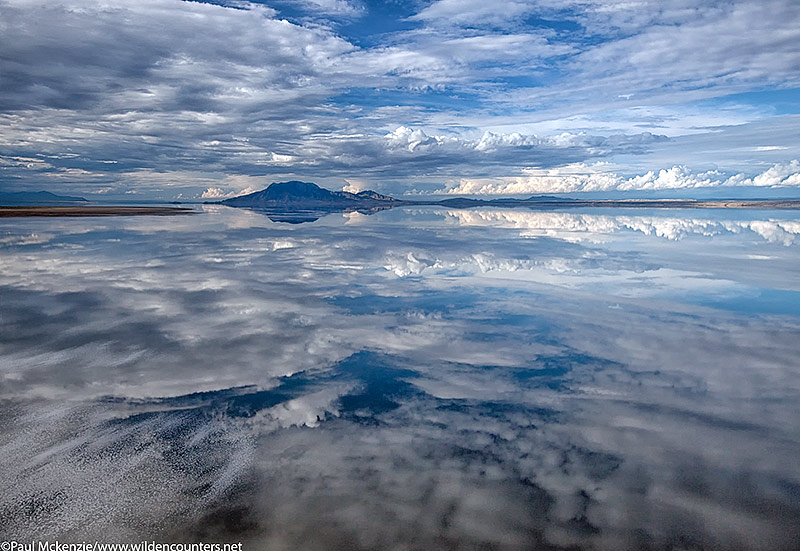
High water – Lake Natron during the rainy season in May, showing Mount Shompole (Kenya) in the distance. The still waters create an almost perfect mirror of the sky.
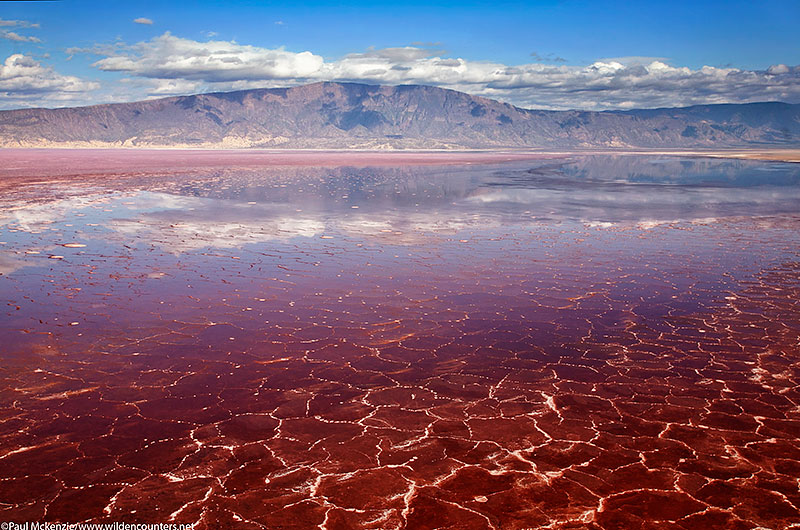
Shallow water – The scene that greeted me on my very first aerial excursion to Lake Natron during the dry season – a blood red lake bed with a very thin covering of lake water
A large portion of Lake Natron and portions of Lake Logipi are relatively dry for much of the year or are covered with just a thin layer of water. The lake bed underneath is made up of a brittle crust of sodium bicarbonate that lies over a bed of thick, gooey mud. The combination of the corrosive waters, searing temperatures and a lake bed that simply cannot be traversed by mammals, means that this is an environment that is alien to almost all life forms. Yet Flamingos have made this ecosystem their home and have positively thrived in this hostile landscape. They share the soda lakes with just a few plant, fish and crustacean species which have adapted to the challenging conditions and by far the most abundant is a microscopic algae species which has evolved perfectly to withstand the harsh conditions and which breeds in prodigious numbers. It is this algae that forms the primary food source for the Flamingos. The lake beds contain huge numbers of the microscopic algae and it is the algae that help to impart the vivid colours that often characterize the lake beds. These same carotenoid pigments in the algae are broken down by enzymes in the bird’s liver to give the Flamingos their distinctive pink colouration.
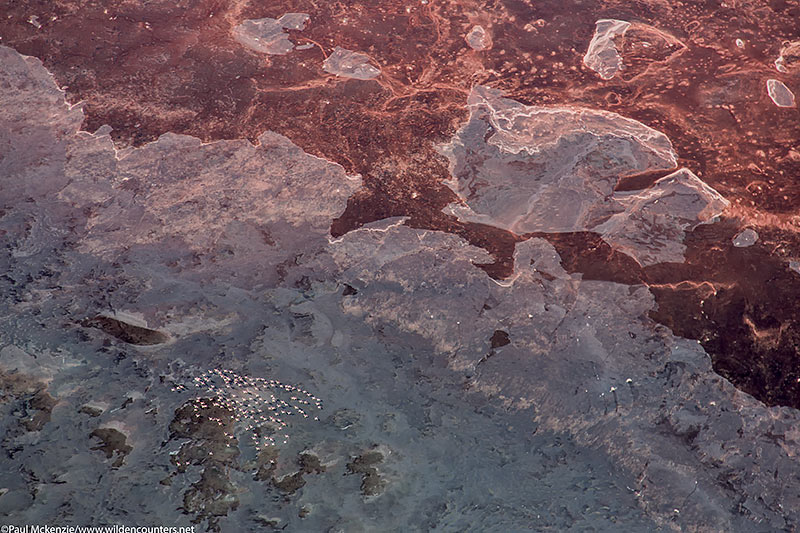
Aerial image of a small group of Lesser Flamingos flying over the dry lake bed of Lake Natron, Tanzania. The sodium bicarbonate crust is infused with vast quantities of a microscopic algae that produces a carotenoid pigment resulting in the vivid red colours. Depending on water levels and mineral concentrations, these colours can evolve into different shades.
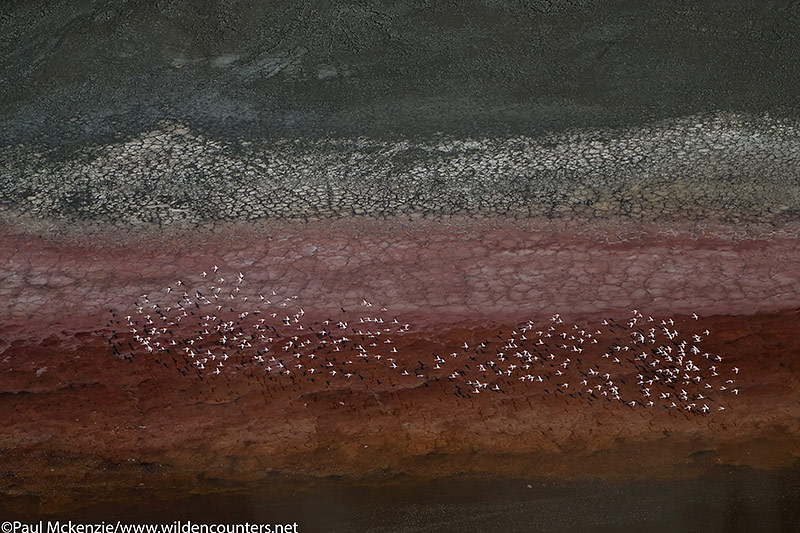
Lesser Flamingos flying over the lake bed of Lake Magadi, Kenya
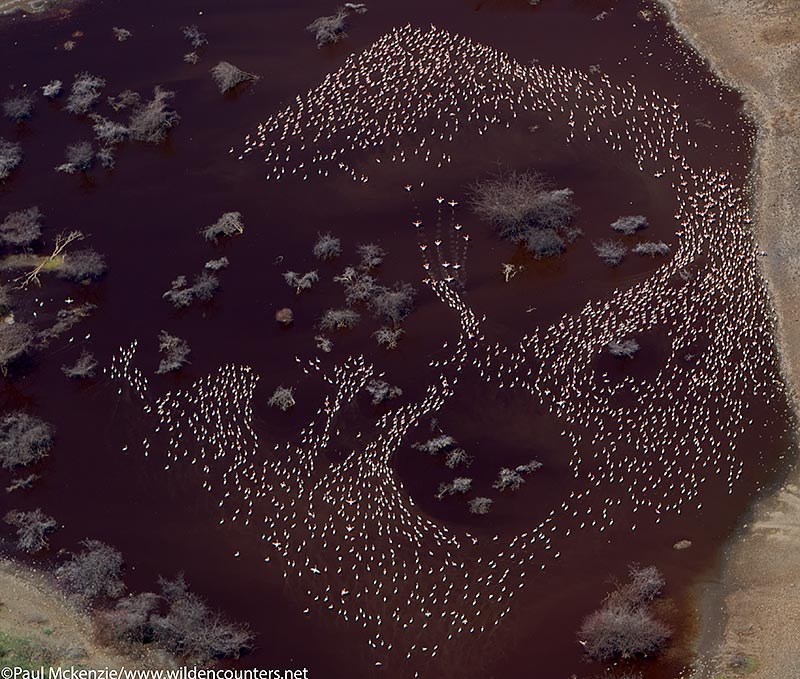
Aerial image of Lesser Flamingos on algae infused pool near Lake Bogoria, Kenya
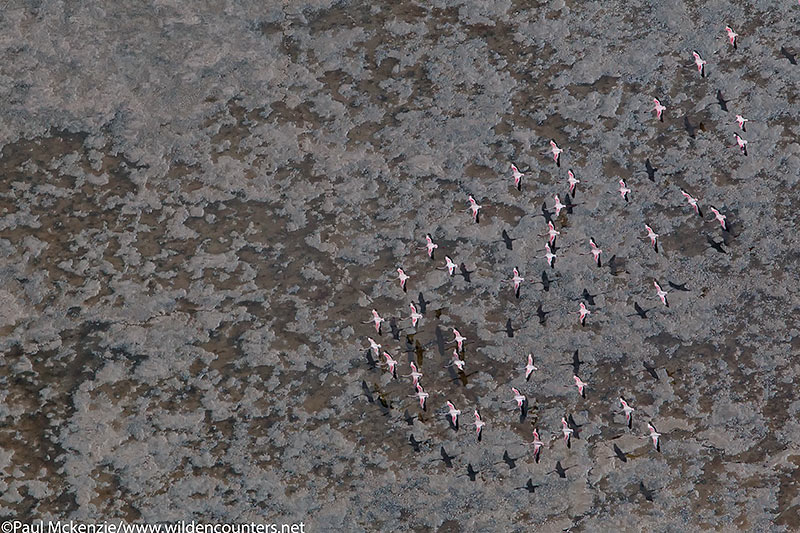
Aerial image of Lesser Flamingos flying over sodium bicarbonate lake bed, Lake Natron, Tanzania
Mineral concentrations on Lake Logipi are not as intense as in Lake Natron and the sodium bicarbonate crust is less evident. Instead, the shallow waters lie over a coating of silt, which in turn sits on top of a thick layer of blue black, viscous mud. When the Flamingos walk through the waters and silt, black trails in the mud are revealed.
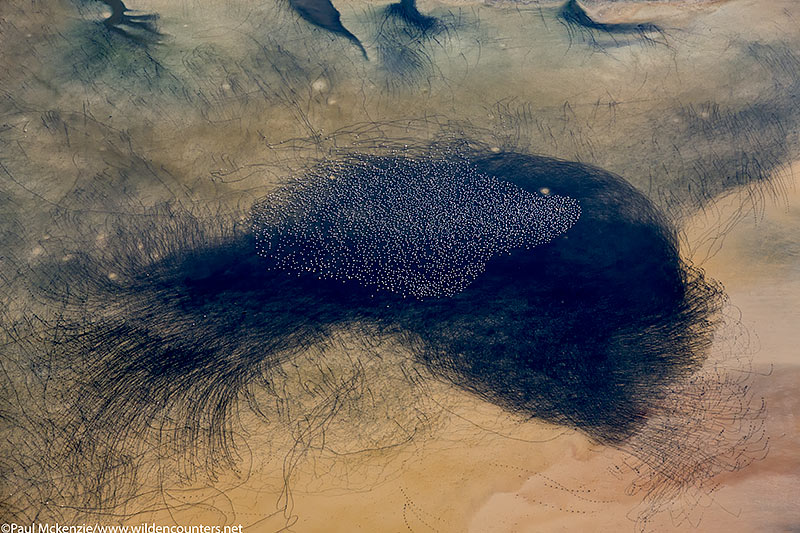
Aerial image of Flamingos and trails, Lake Logipi, Kenya
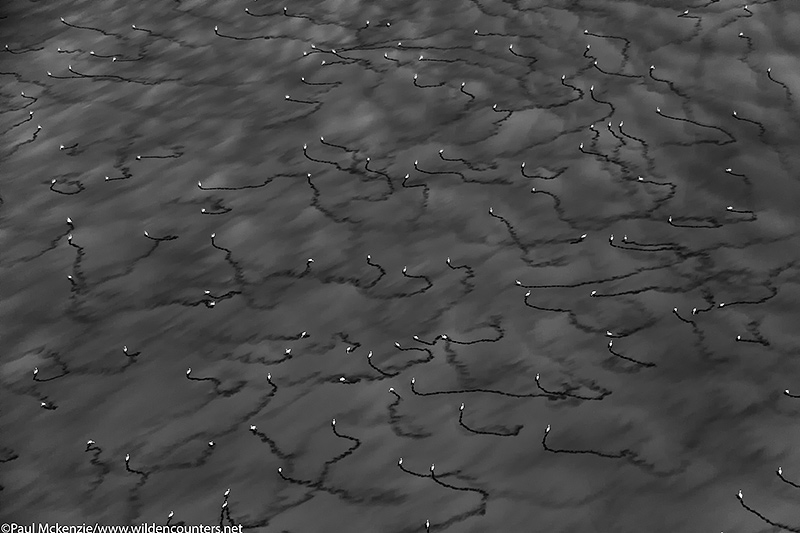
Flamingo doodle – aerial image of Flamingos and their trails, Lake Logipi, Kenya
Aerial image of Lesser Flamingos and trails on shallow water lake, Lake Logipi, Kenya
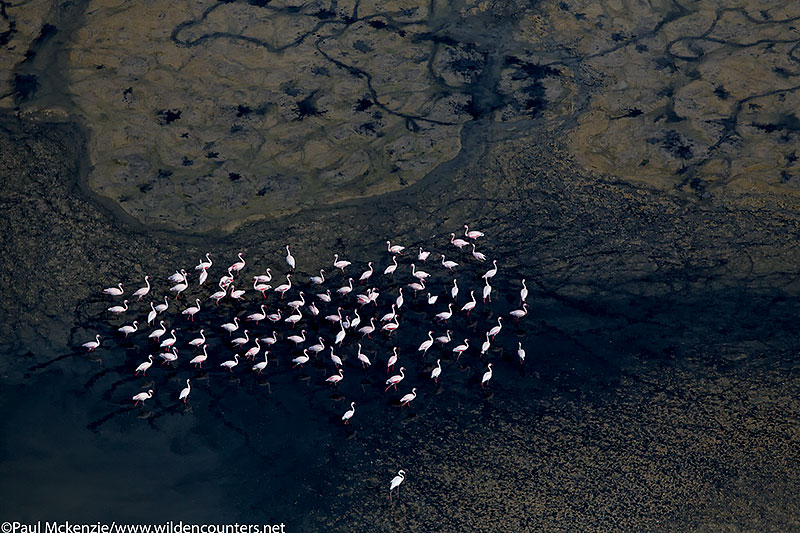
Aerial image of Lesser and Greater Flamingos and trails on shallow water lake, Lake Logipi, Kenya
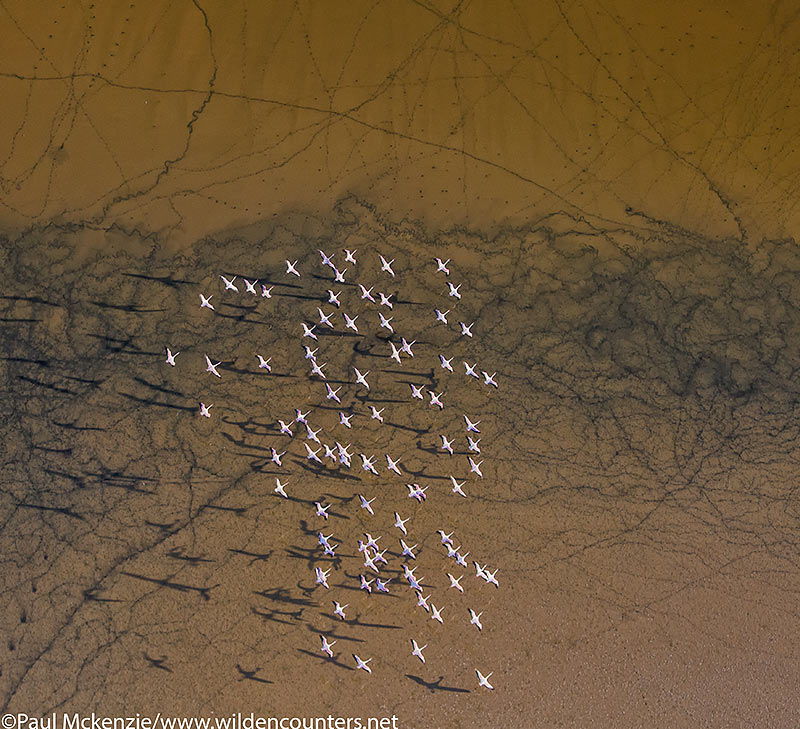
Aerial image of Lesser Flamingos flying over shallow water lake with mud trails visible through the silt, Lake Logipi, Kenya
Lesser Flamingos are not wedded to any one soda lake and will move from lake to lake searching for optimal conditions. The birds will sometimes travel large distances, to Ethiopia, South Africa, Namibia, Botswana and Mauritania in West Africa. Smaller populations can also be found on occasion in North West India. Sometimes the birds will favour one lake during the day and then roost on another at night before returning to the original lake the next day. In Flamingo Crater Lake on Central Island in Lake Turkana, this is precisely what happens. In early 2011, I spent three blisteringly hot days in this crater waiting for the birds to lift off at the end of day, after which they would fly a few times around the crater rim before departing.
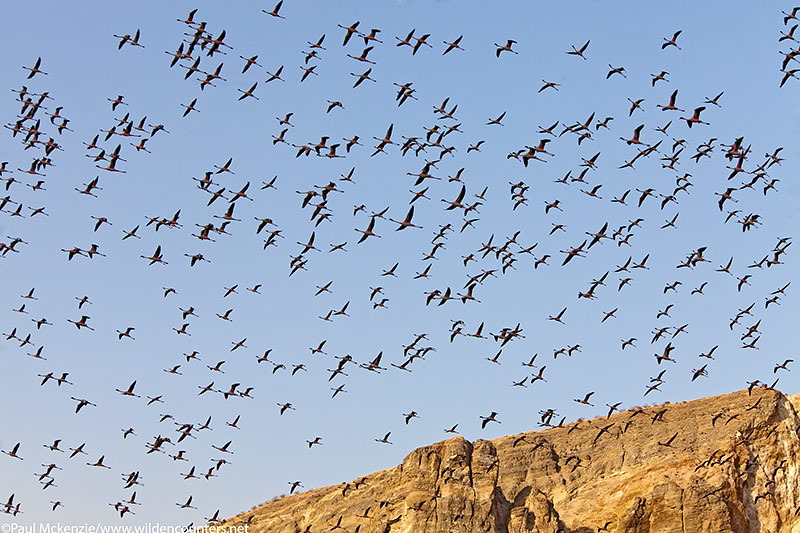
Lesser Flamingos flying over the crater walls of Flamingo Crater Lake, Central Island, Lake Turkana, Kenya
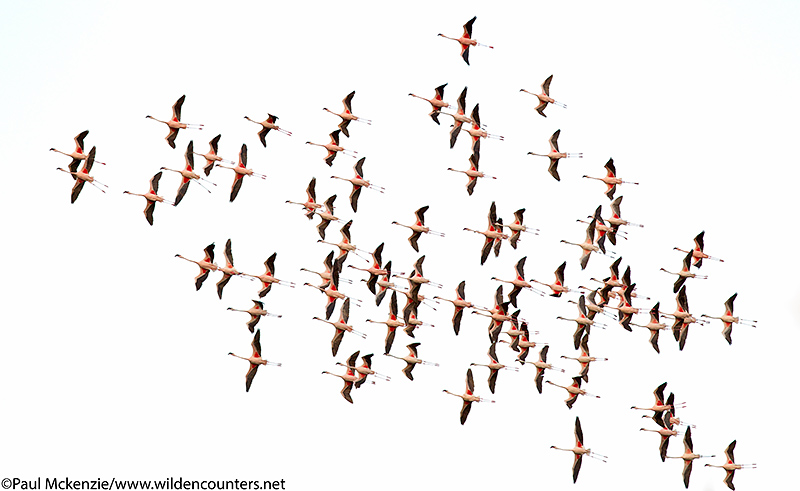
Lesser Flamingos soaring against white sky, Flamingo Crater Lake, Central Island, Lake Turkana, Kenya
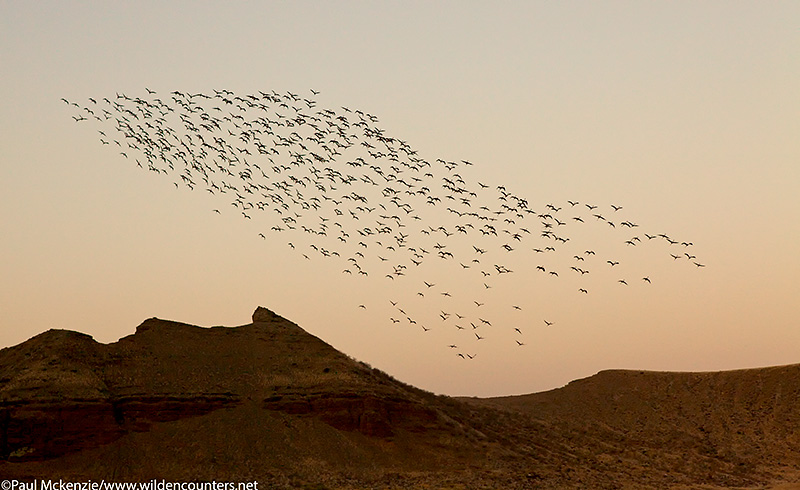
Lesser Flamingos flying over crater walls at dusk, Flamingo Crater Lake, Central Island, Lake Turkana, Kenya
Central Island is not far from Lake Logipi and it is likely that this is where the birds would go each night.
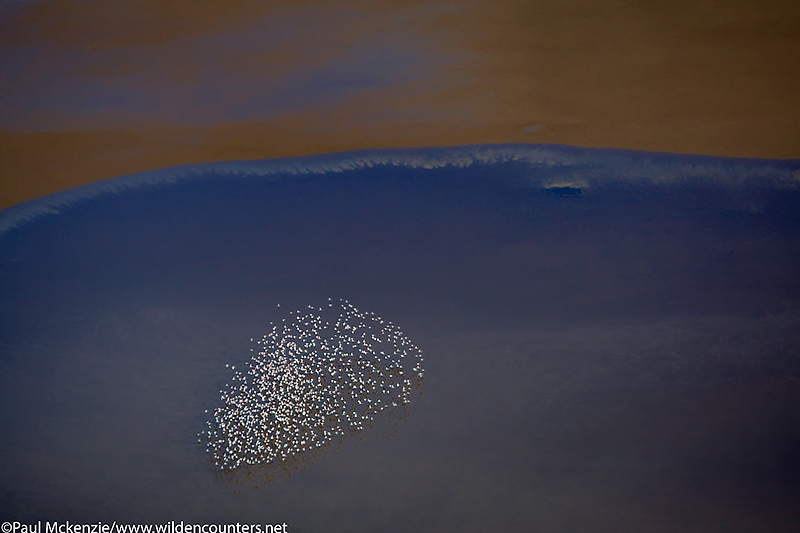
Lesser flamingos flying over Lake Logipi, Kenya
As a photographer, I have found myself increasingly drawn to the painterly, abstract patterns of the soda lake beds and shores. If ever art can be found in nature, these are surely primary examples.
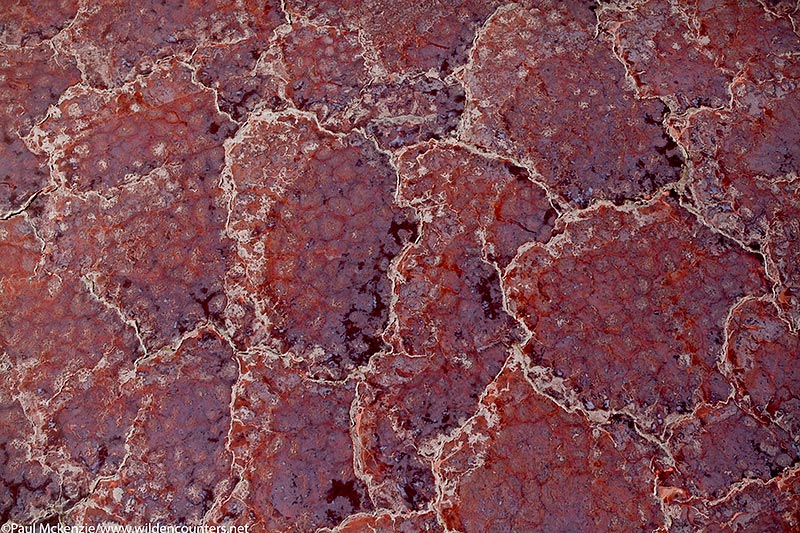
Aerial image of sodium bicarbonate and hydroxide crust patterns on Lake Natron, Tanzania. The distinctive colours are produced by vast quantities of algae within the chemical compounds.
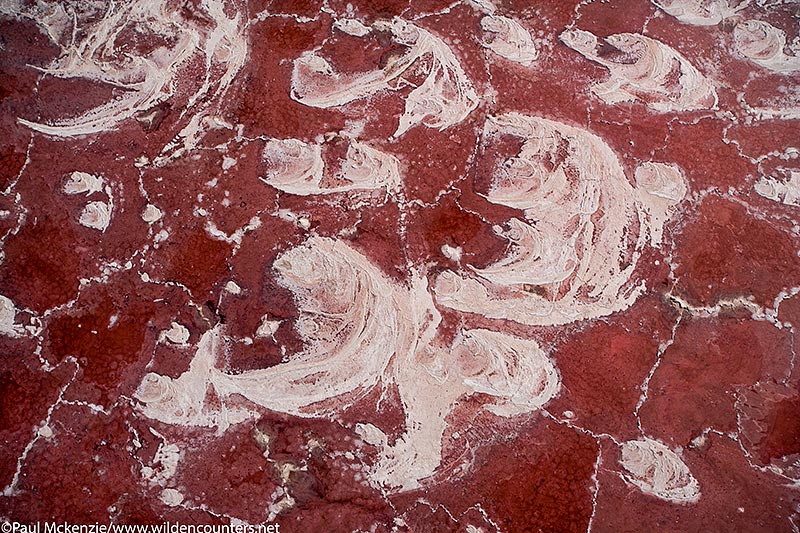
Aerial image of sodium deposits on the lake bed of Lake Natron, Tanzania
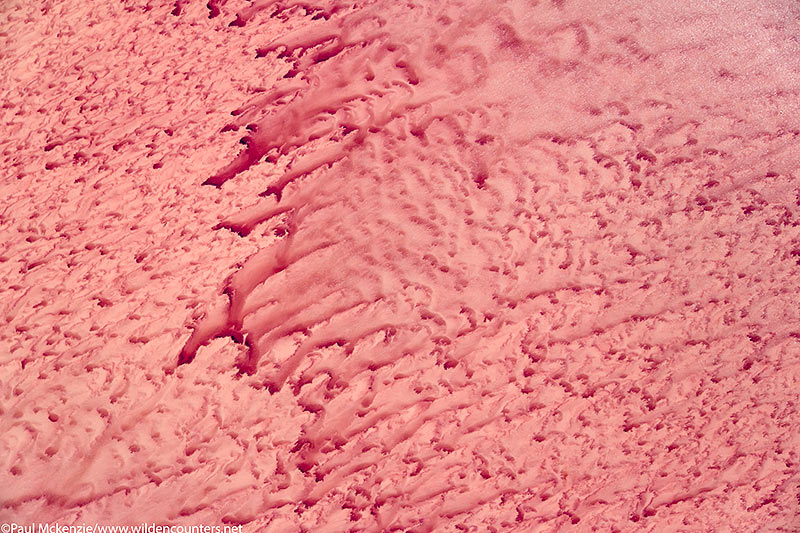
WTF! seriously, this is nature and not an artist’s canvas. I’ve always thought that any artist suffering from artist block or simply lacking inspiration should take an aerial flight over some of the world’s soda lakes. This is Lake Logipi in northern Kenya.
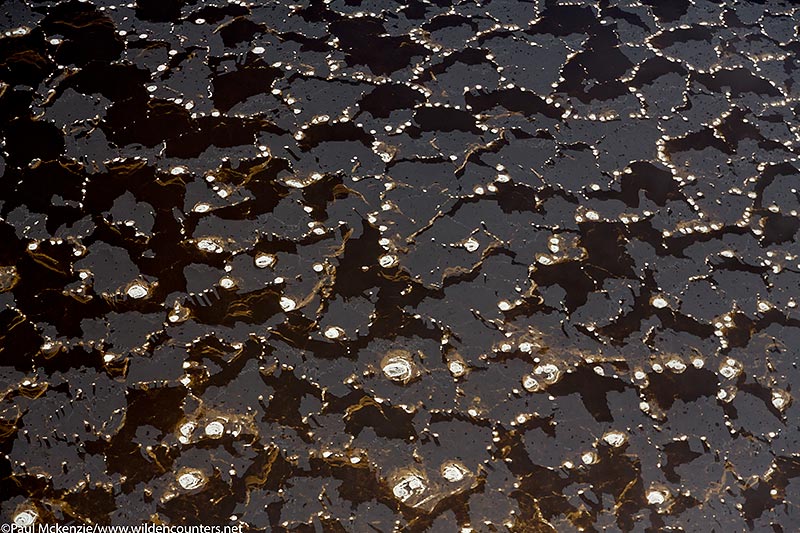
Sodium deposits on top of the sodium bicarbonate crust lining the bed of Lake Natron. I love these abstract patterns. Here they look like strings of pearls.
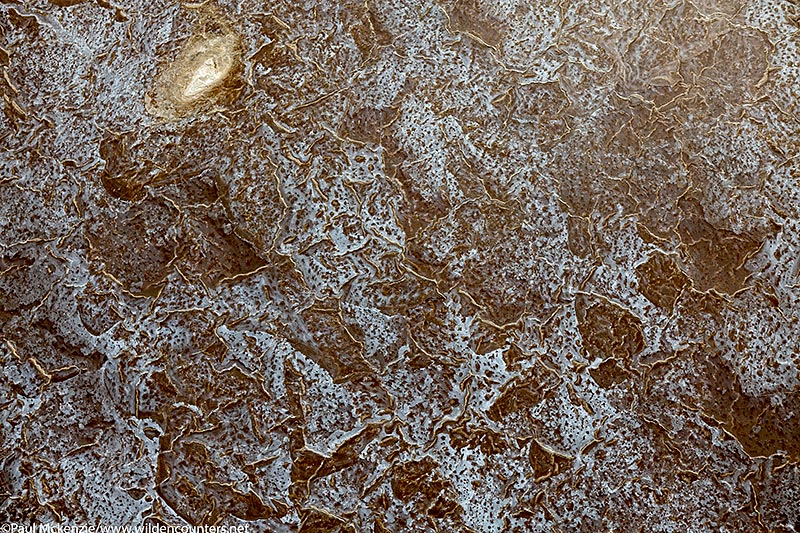
More weird and wonderful lake bed patterns formed by sodium and phosphate deposits with colouring provided by the algae, Lake Natron, Tanzania
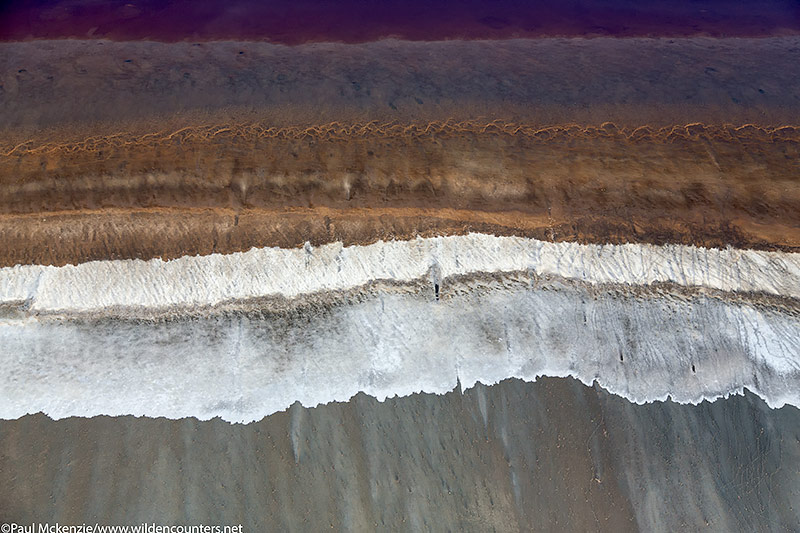
As a photographer, I’ve always been attracted to bands of colour. The shore line on Lake Natron serves up opportunities in abundance.

More mineral deposits and colour bands on the shore of Lake Natron
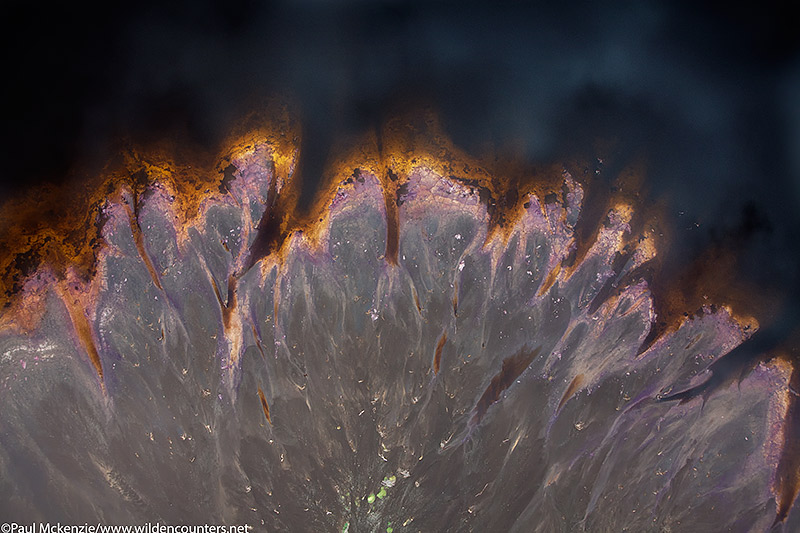
Sodium bicarbonate & sodium hydroxide infused with microscopic algae on the delta waters at the edge of Lake Natron, Tanzania
Concentrations of mineral deposits often form small islands on Lake Natron. From the air, these islands have an oil painting quality about them. The reflections of clouds on the dark, still lake surface adds to the artistic impression. 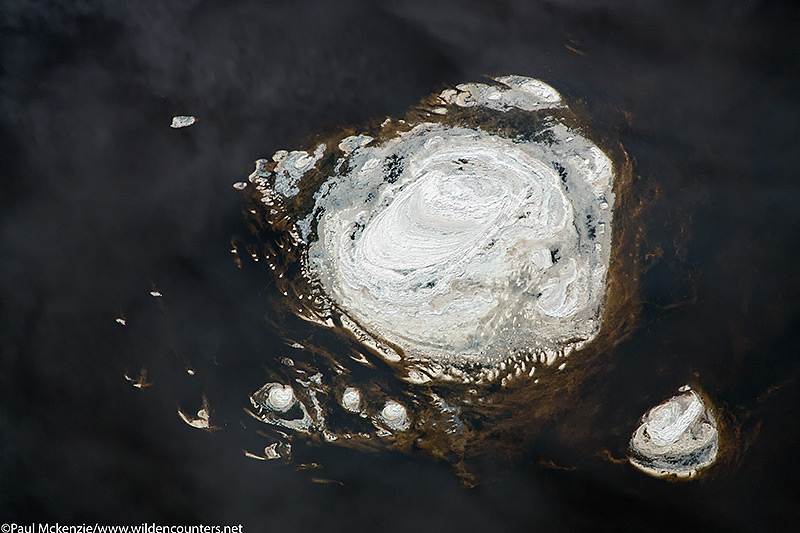
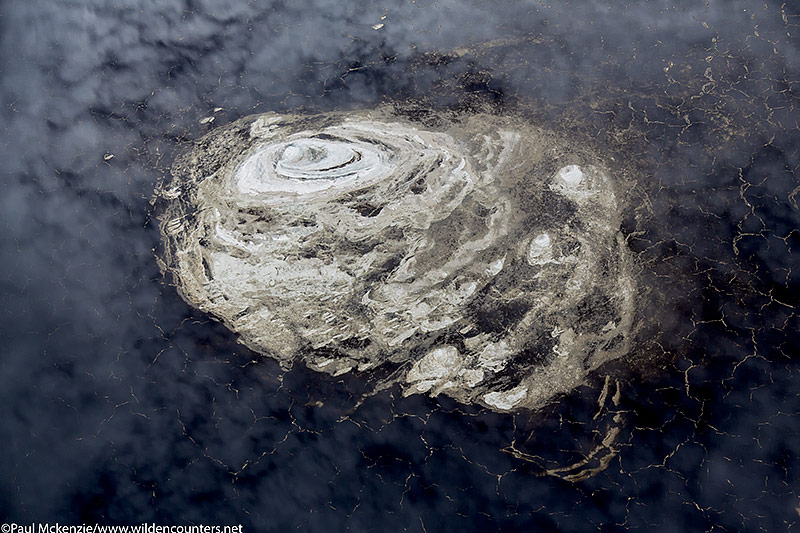
One of the more unusual features of the soda lakes is that the searing temperatures around the lake result in high evaporation rates. From the air this sometimes gives the appearance that the lake shore and lake bed are disintegrating. In turn, this produces some wonderfully photographic patterns, many with a surreal abstract quality.
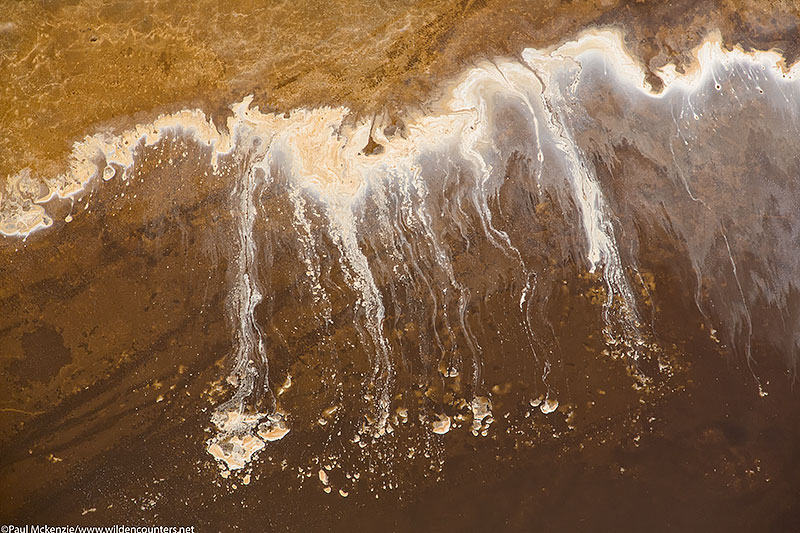
Evaporating sodium/phosphate compounds on the surface of Lake Natron
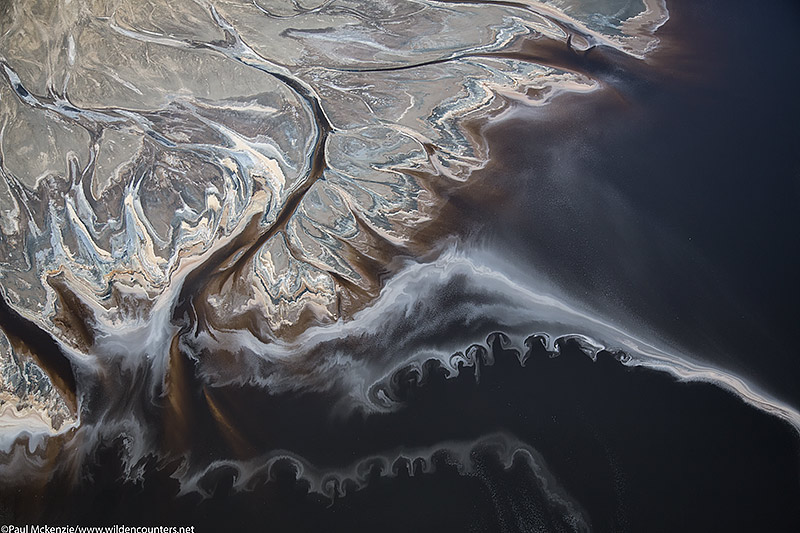
Evaporating mineral trails on the surface of Lake Natron beside a lake shore delta heavily encrusted with sodium and phosphate compounds
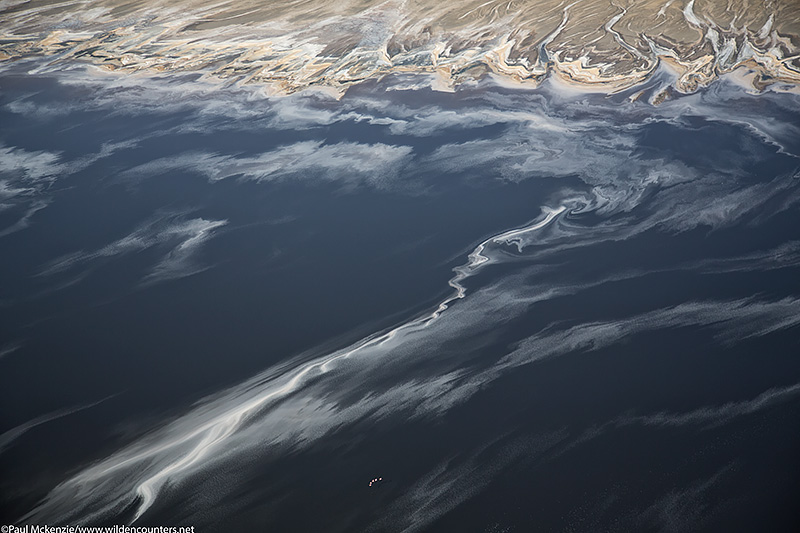
Aerial view of a small group of Lesser Flamingos flying over Lake Natron with trails of evaporated sodium compounds on the lake surface.
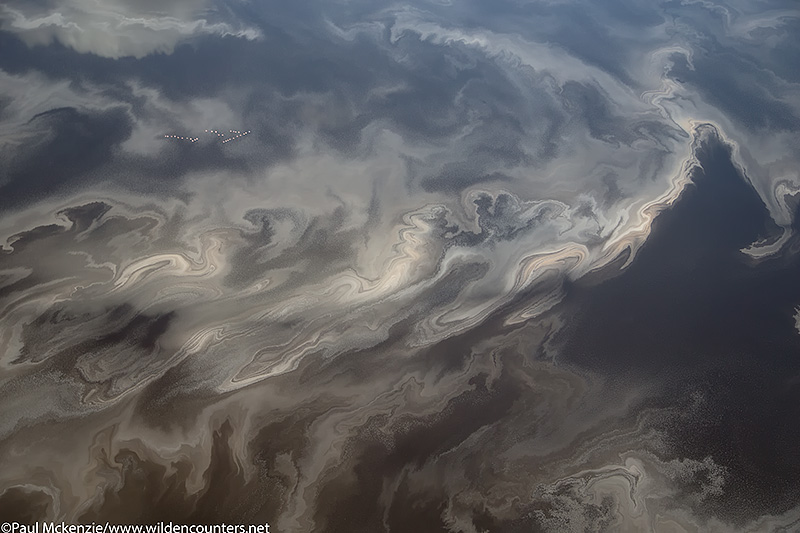
Aerial view of a small group of Lesser Flamingos flying over Lake Natron with trails of evaporating sodium and phosphate compounds of the lake surface
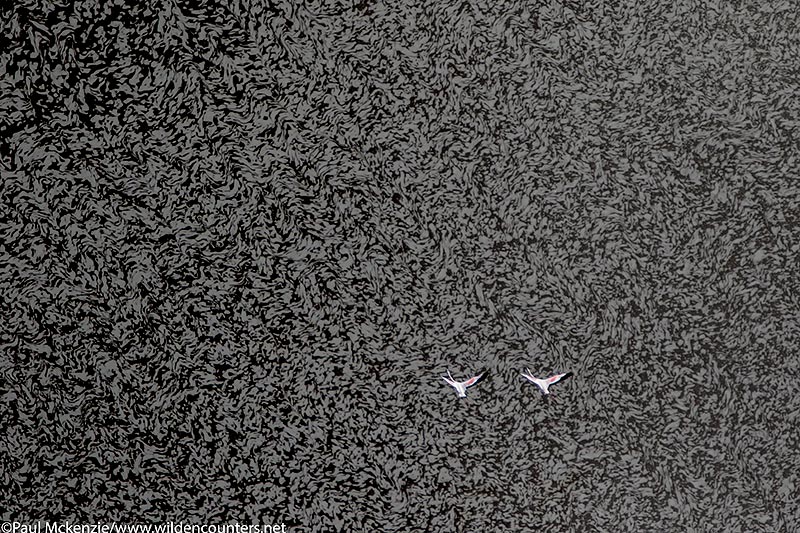
How cool is this? Aerial image of Lesser Flamingos flying over evaporating sodium compounds on the surface of Lake Natron, Tanzania
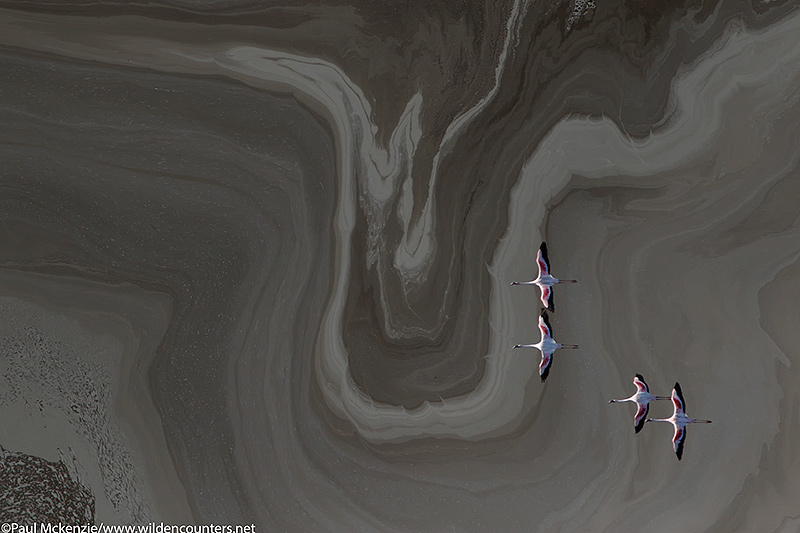
Aerial image of Lesser Flamingos flying over evaporating sodium compounds on the surface of Lake Natron, Tanzania
The evaporating mineral compounds are sometimes mixed with algae slicks.
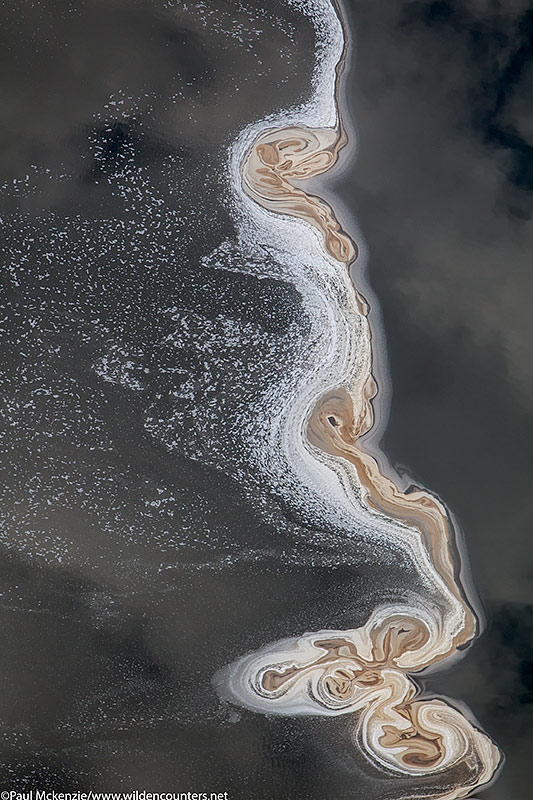
Clouds in my coffee. Aerial view of algae slick and trails of evaporated sodium and phosphate compounds on the surface of Lake Natron, Tanzania.

More oil paint abstracts – Algae slick, Lake Logipi, Kenya. Aerial view of lime green and pink algae slick on the surface of lake.
The algae slicks often draw large numbers of Flamingos.
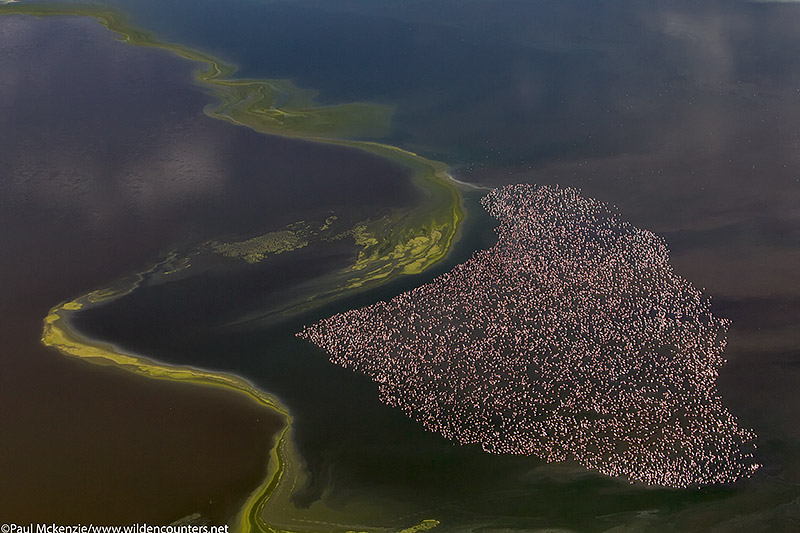
Lesser Flamingos on shallow water lake beside algae slick, aerial shot, Lake Logipi, Kenya
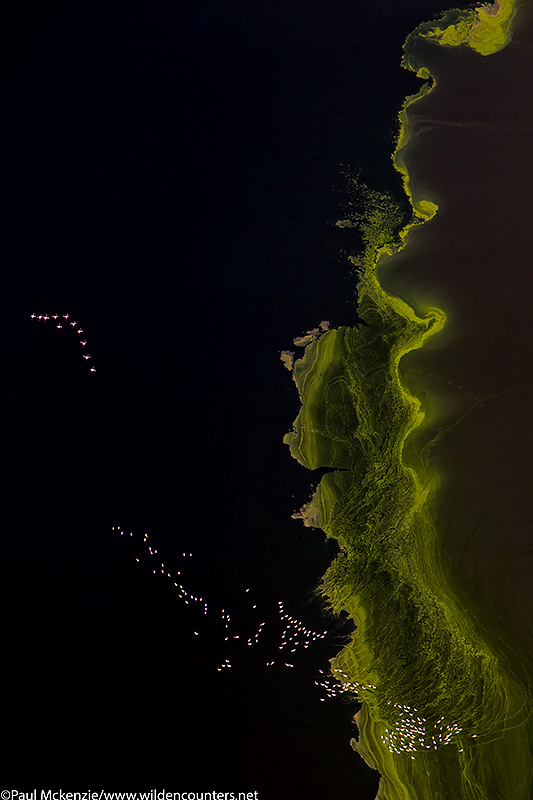
Flamingos on, beside and flying by an algae slick, Lake Logipi, Kenya
Sometimes huge blooms of algae can cover vast sections of a soda lake such as in this instance on Lake Bogoria.
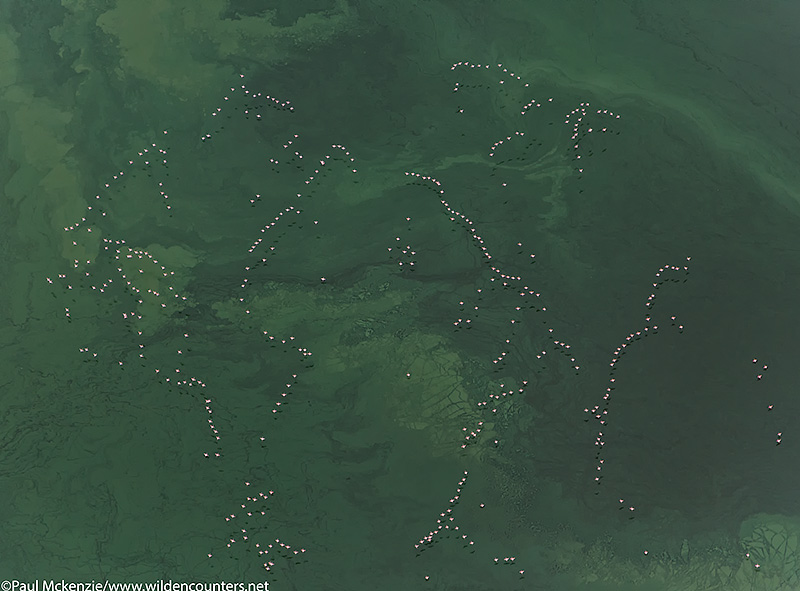
Aerial image of Flamingos flying over algae bloom, Lake Bogoria, Kenya. Can you make out the partial outline of some of the world’s continents?
When conditions are right on the lakes, specifically: the water is shallow, the alkaline content of the water and the concentrations of algae, high, East Africa’s soda lakes can draw staggeringly large Flamingo numbers. Flocks of over a million birds have been recorded, easily the largest gathering of an inland water bird on our planet.
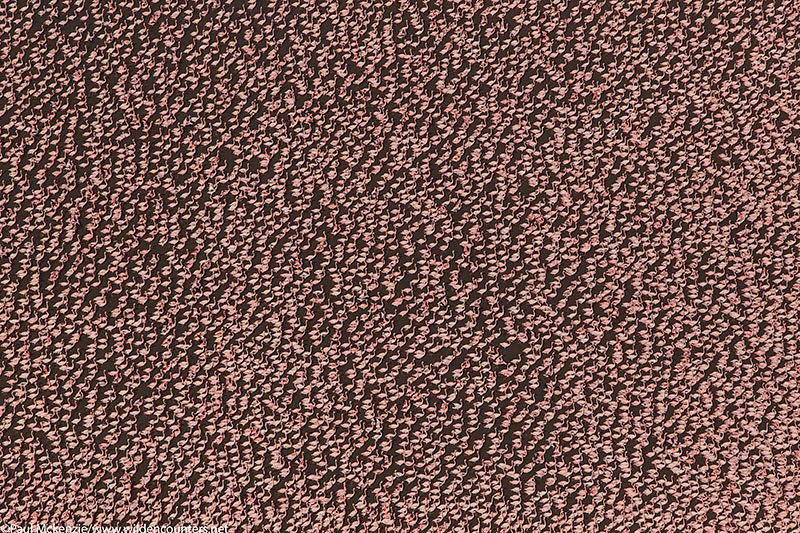
Aerial image of thousands of Lesser Flamingos grouped tightly together, Lake Logipi, Kenya
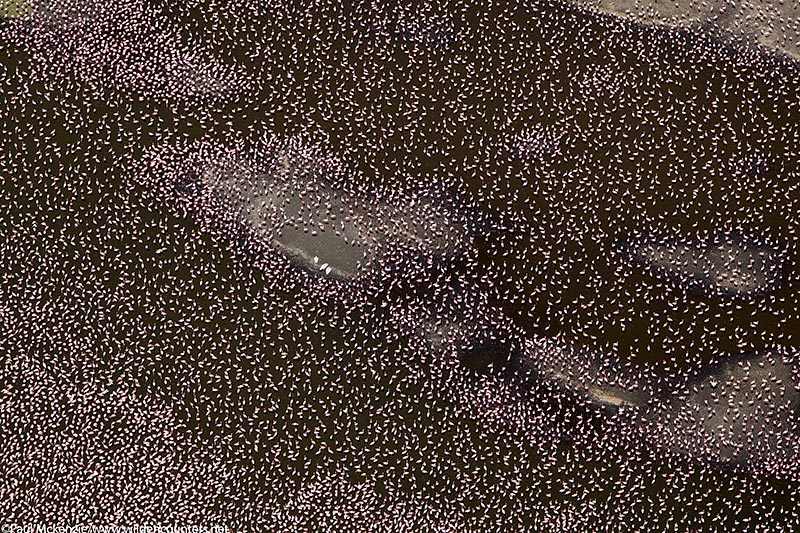
Aerial image of thousands of Lesser Flamingos carpeting the shallow waters and shore of Lake Bogoria, Kenya
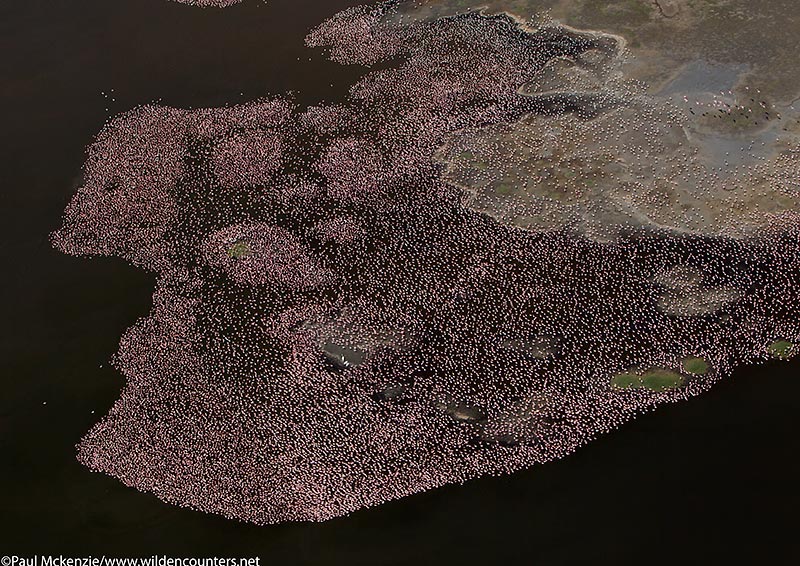
Aerial image of thousands of Lesser Flamingos lining the shore and adjacent shallow waters of Lake Bogoria, Kenya
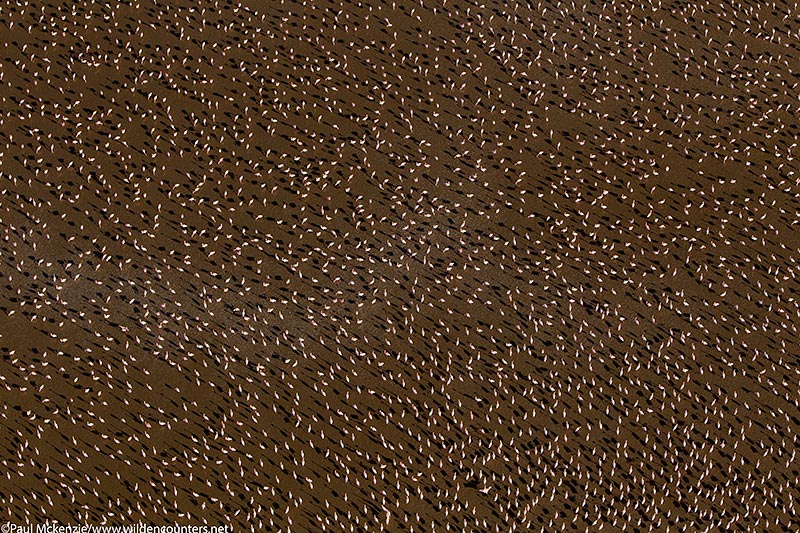
Aerial image of hundreds of Greater and Lesser Flamingos feeding in the shallow waters of Lake Logipi, Kenya
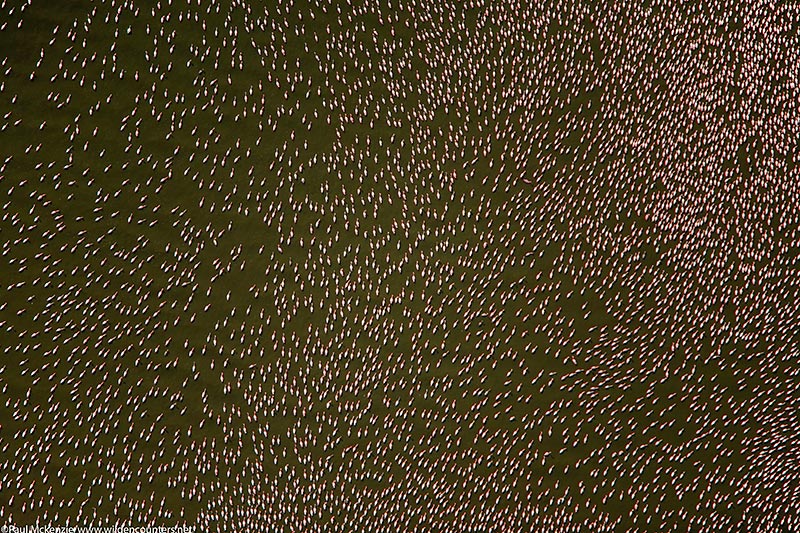
Aerial image of hundreds of Lesser Flamingos feeding in the shallow waters of Lake Logipi, Kenya
Lake Natron is one of the few soda lakes in Africa where Flamingos breed on a regular basis. The birds build nests out of mud in locations where it can be easily extracted between the plates of the sodium bicarbonate crust, typically out in the middle of the lake where no four or two legged predators can venture.
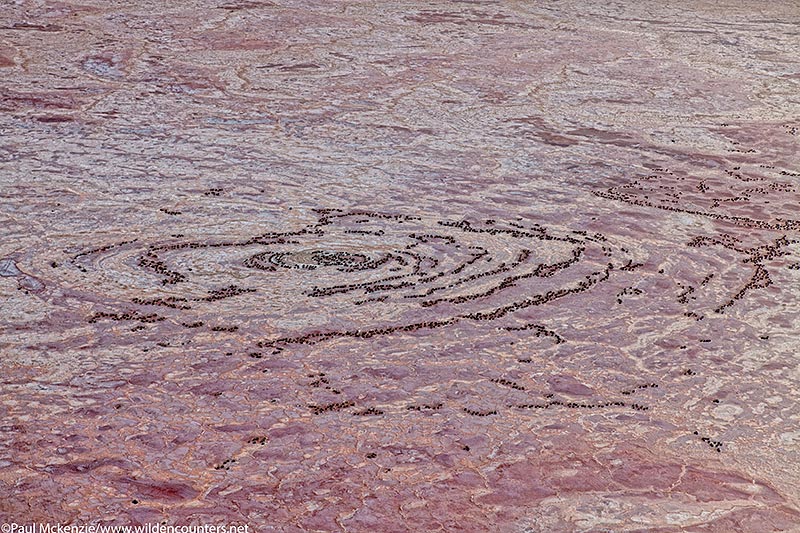
Aerial image of Flamingo nests on sodium bicarbonate crusted lake bed, Lake Natron, Tanzania
The Flamingos become sexually mature at seven years and like Albatrosses (my other favorite avian species), they usually pair for life. The female lays a single egg and they form large colonies such that breeding takes place en masse. There is no fixed time table to the breeding but it is usually in dry periods which facilitate nest building. Only about 20% of breeding adults mate and lay eggs in any one year. 20% can still add up to considerable numbers. Two weeks after hatching, the chicks migrate in large groupings, usually led by a single adult, across the scorching lake bed to the shore where there are a permanent fresh water lagoons. In early 2011, one of my aerial excursions fortuitously coincided with this event. I was only vaguely aware of this behavior mainly through the incredible “Crimson Wing” documentary (surely one of the finest wildlife documentaries ever produced) and could not believe my luck when I realized what was unfolding beneath me.
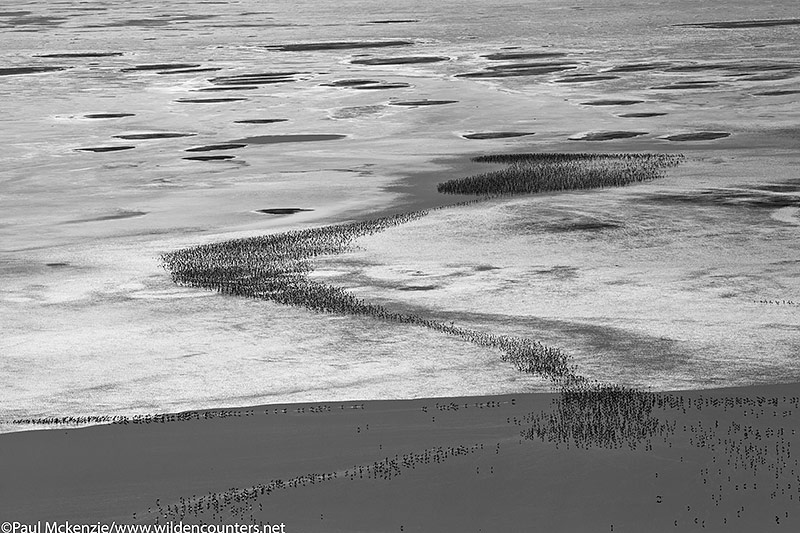
Aerial image of fledgling Flamingo chicks tracking across the lake bed of Lake Natron, Tanzania

Aerial image of Lesser Flamingos chicks tracking across the shallow waters of Lake Natron, Tanzania
The juvenile Flamingos lack the pink and red colouration of their parents and this is only gradually acquired over time following prolonged algae ingestion.
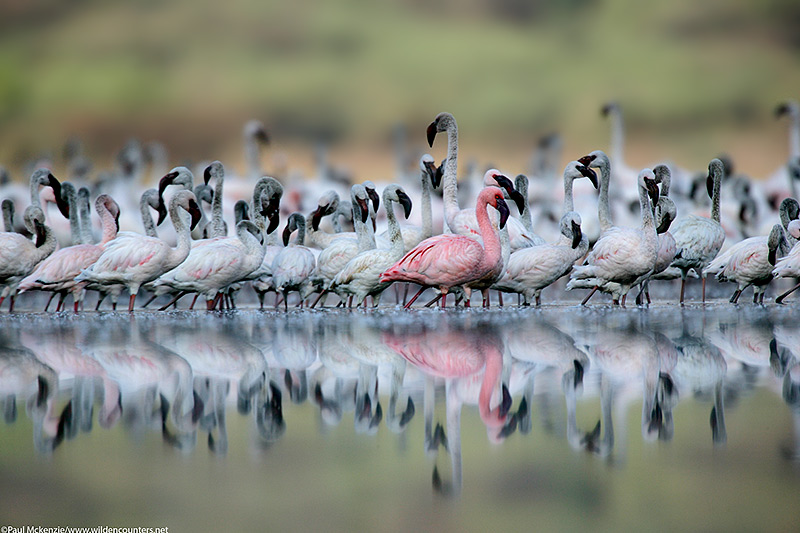
Juvenile Lesser and Greater flamingos together with a single Lesser Flamingo adult, Lake Bogoria, Kenya
Lake Nakuru, Elementatia and to a lesser extent, Lake Bogoria are set in more temperate surroundings without the searing temperatures and high evaporation rates of Natron and Logipi and hence have lower mineral concentrations. These temperate lakes do not serve as breeding grounds and hence the predatory risk to chicks is a non-issue. However, for the adults and juveniles, it is a different story. Baboons have adapted to catch Flamingos in the fresh water streams of Bogoria and in Nakuru the threat comes from Hyenas.
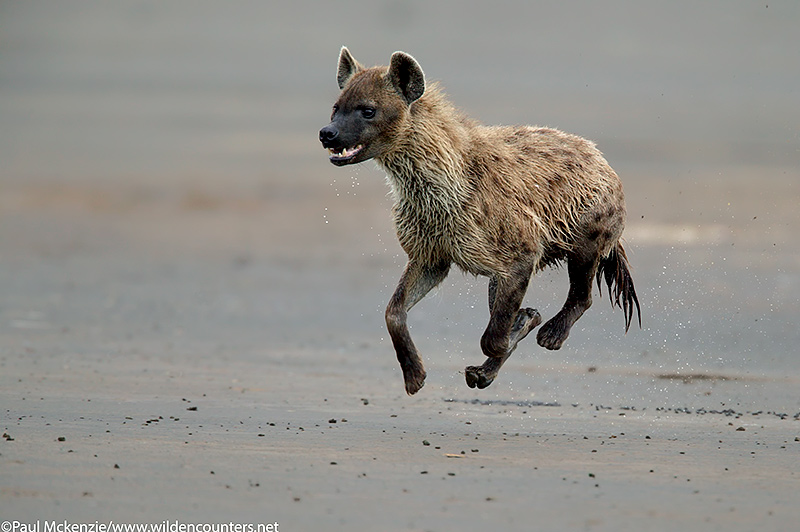
Spotted Hyena running along the shore, Lake Nakuru, Kenya
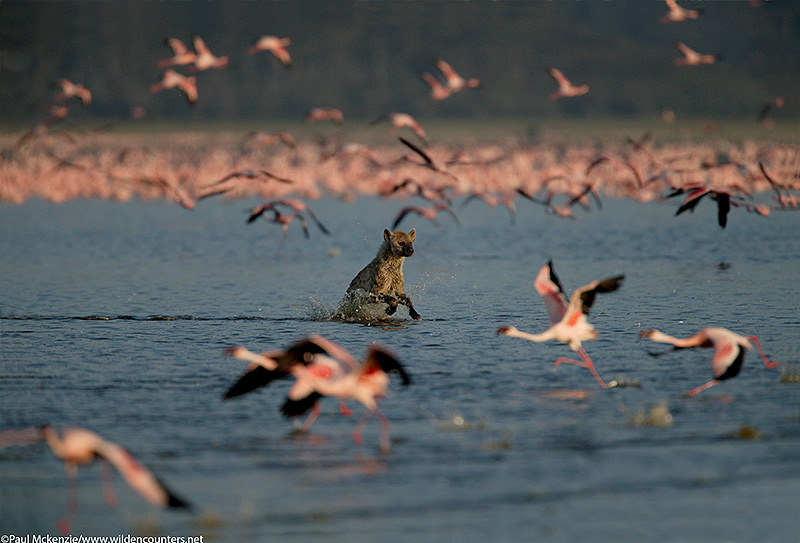
The Hyena’s strategy for hunting Flamingos appears haphazard. They simply charge into the water towards large groups of the birds. There is however, method to their apparent madness. The Flamingos are alert and a healthy bird can comfortably take flight. On the other hand, while most of these chases culminate in failure on the part of the Hyena, there is always the chance that a sick or injured bird will not be able to escape in time.
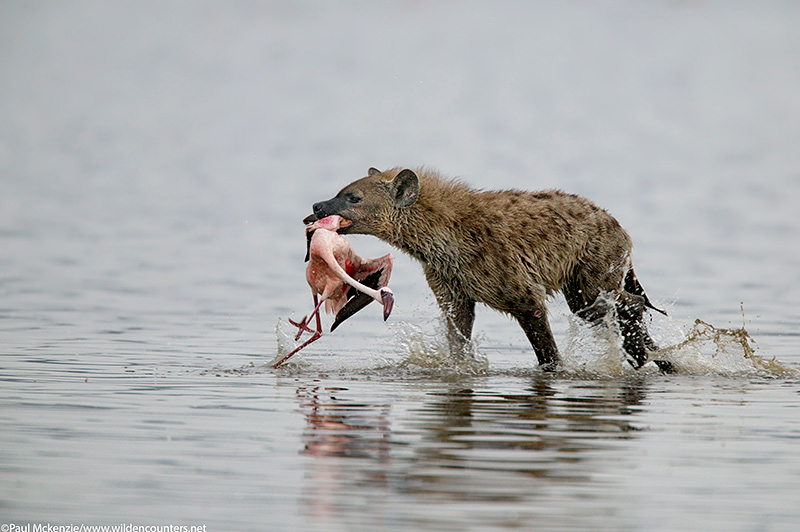
Hyena with flamingo kill, Lake Nakuru, Kenya. With the entire lake shore and large portions of the surrounding Yellow Fever Acacia forest currently flooded due to three years of abundant rainfall (human encroachment and forest clearance has added to the high waters), the lake has been largely devoid of Flamingos for the last three years and it may be a long time before we again witness this type of predatory behavior at Lake Nakuru.
From the air, large groupings of Flamingos sometimes briefly form patterns and shapes that resemble other animals or symbols. These are usually fleeting and so it helps to be alert to them and be able to react quickly with a camera.
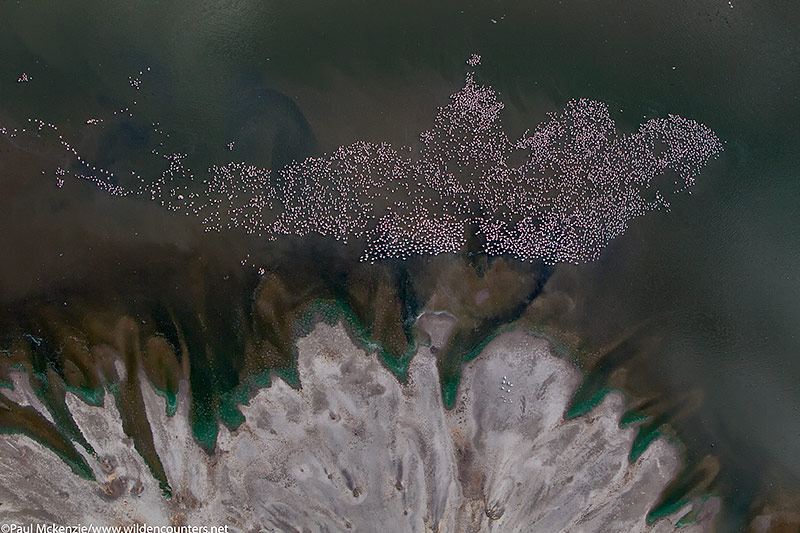
The Elephant Seal
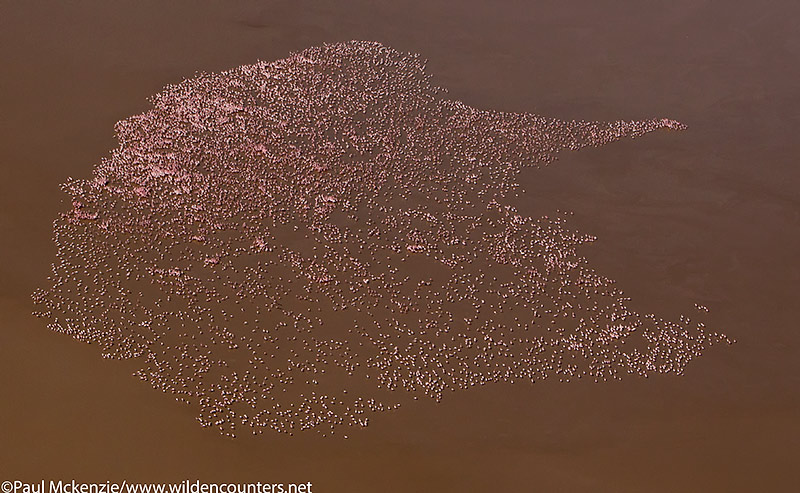
The Shrew
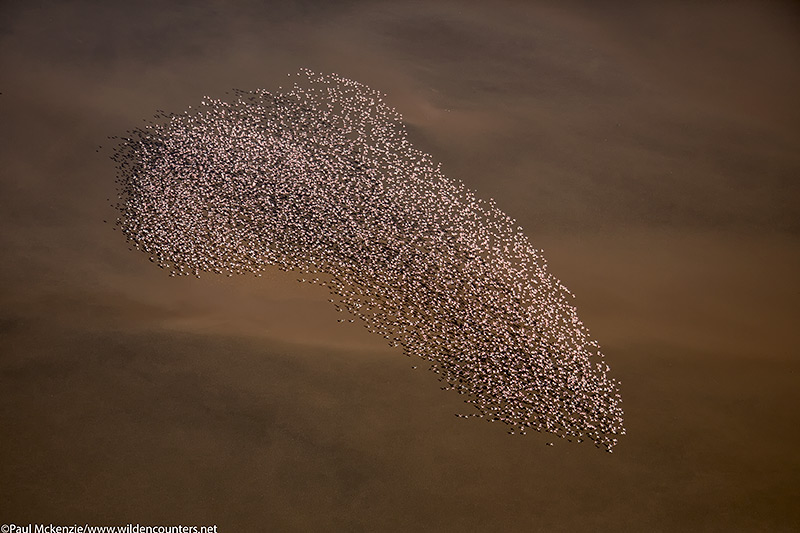
Africa
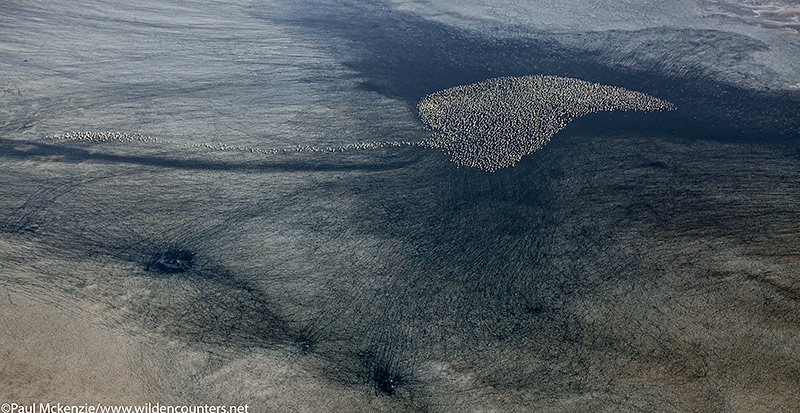
Devil’s tail
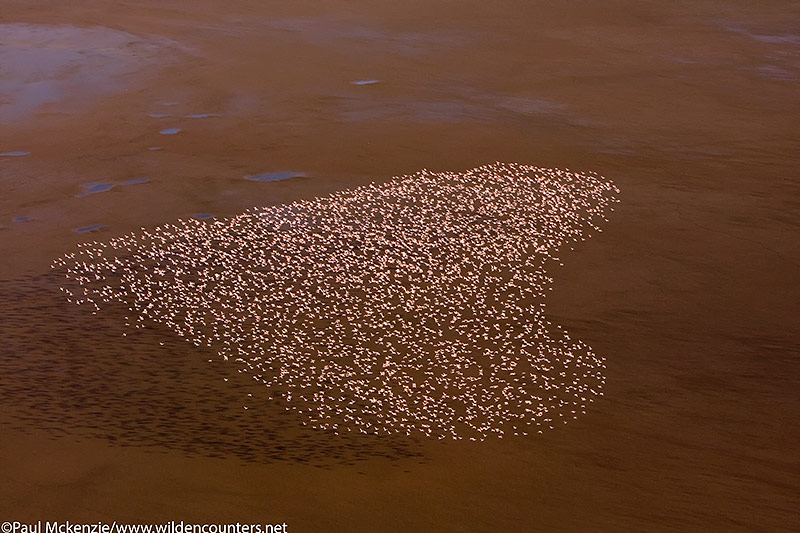
Love heart
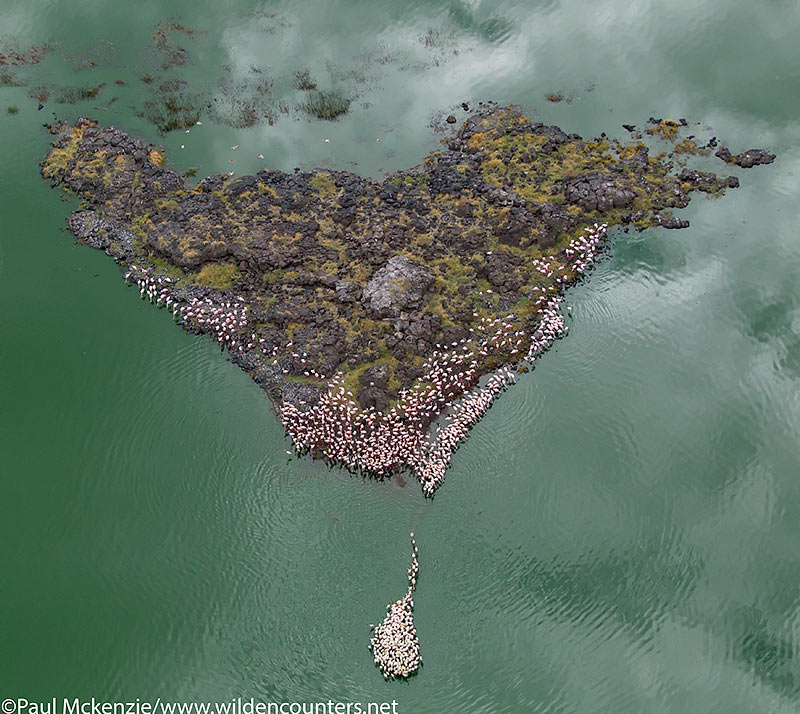
The tear
Flamingos are large birds and require a running start to take flight.
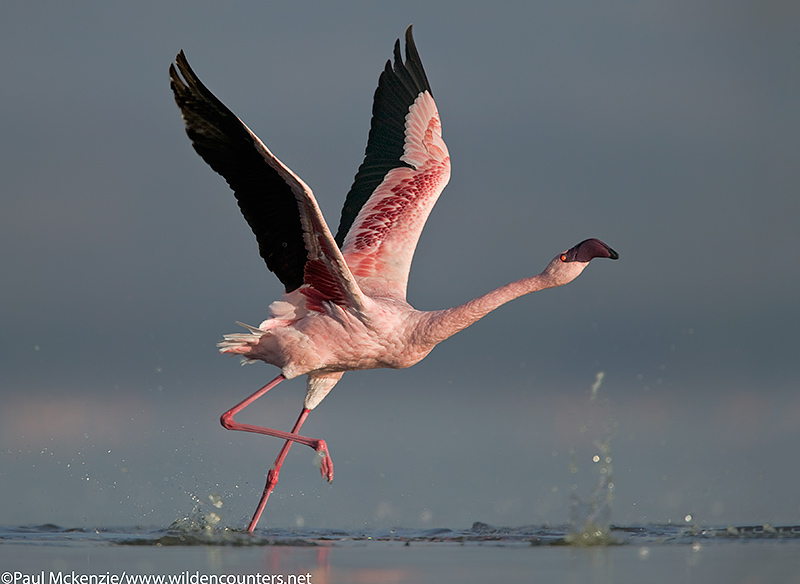
Lesser Flamingo running in shallow water to take flight, Lake Nakuru, Kenya.
Shot backlit from the air, Flamingos leave behind artistic water trails as they run to take flight on the shallow waters of Lake Logipi.
The birds often fly low over the lake waters, in V-shaped formations, reminiscent of bomber squadrons.
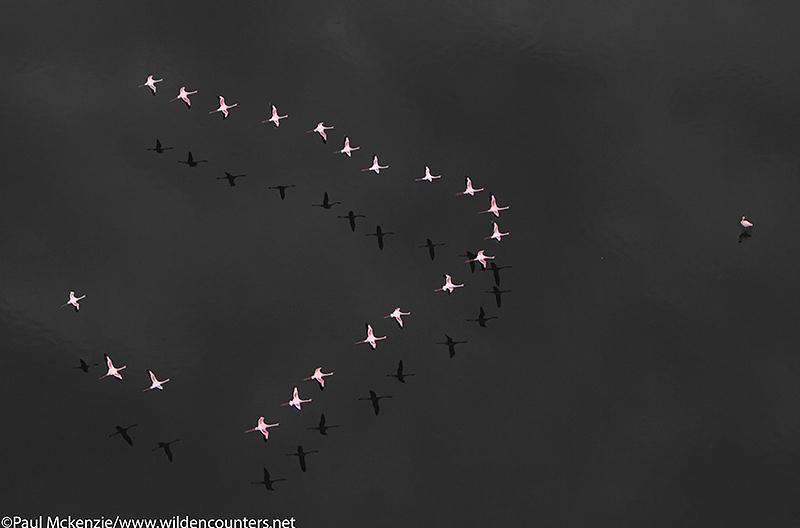
Greetings
In Lake Bogoria and especially on Lake Nakuru, Lesser Flamingos engage in dazzling pre-breeding displays. The spectacle starts with a group of a few birds. Neck and tail feathers are raised as an invitation for other birds to join in and sometimes hundreds join the communal dance. Packed tightly together, some engage in “fencing” with their bills; others thrust their necks and heads skyward while others bend their necks to extreme angles so that their heads rest against their breasts. The birds march in a synchronized fashion at times moving through the shallow waters at a leisurely pace before abruptly speeding up, often with sudden directional changes.
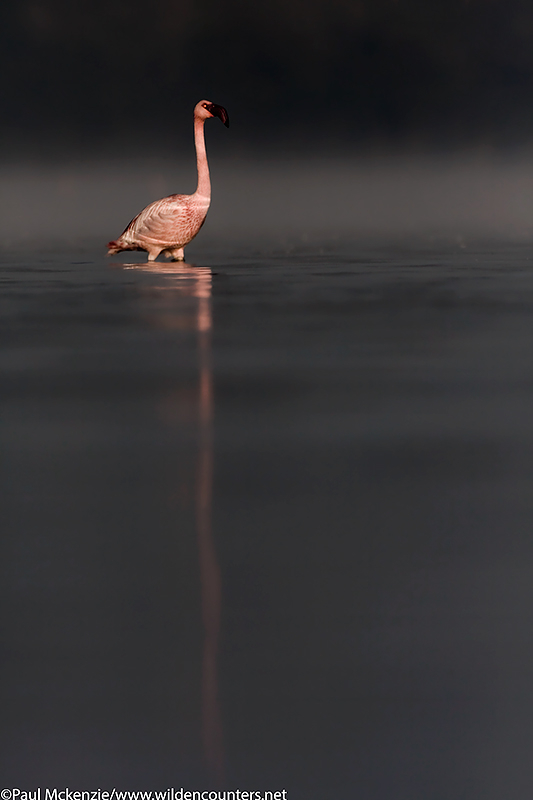
Lesser flamingo in early morning light, on the lookout for potential “dance partners”, Lake Nakuru, Kenya
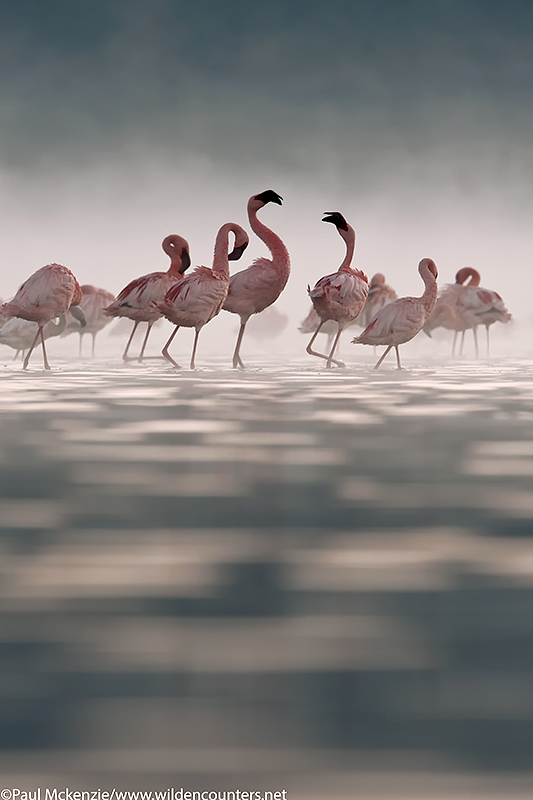
In the early morning mist, a small group come together to engage in bill “fencing”, Lake Nakuru, Kenya
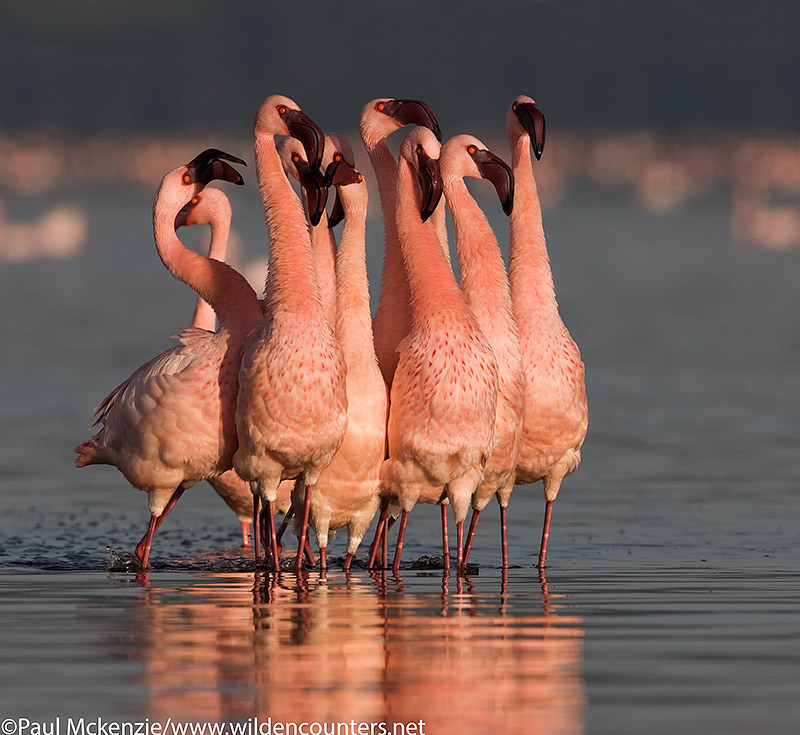
The dance ritual begins
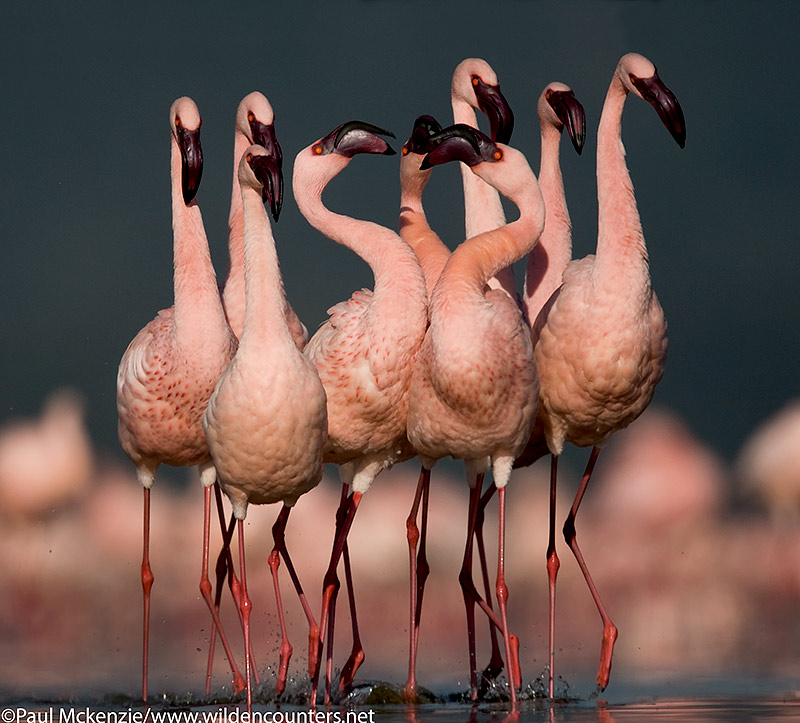
The group begins to move at a fast pace through the shallow waters with ritualistic bill fencing taking place, Lake Nakuru, Kenya
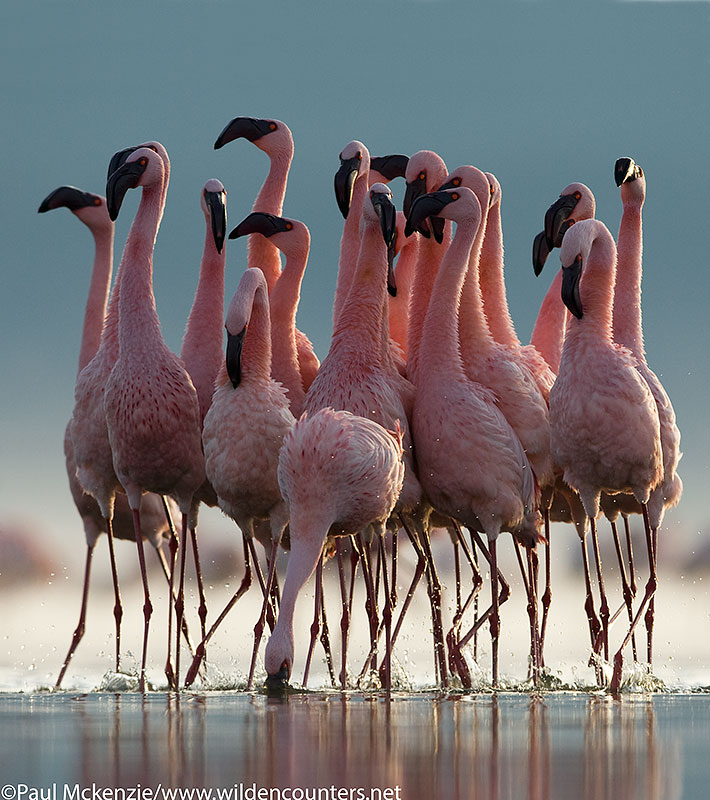
The groups steadily get larger. If you sit or better still, lie on the edge of the lake, the Flamingos will eventually come reasonably close. As with all avian species that are on the ground, getting onto your belly with the lens on the dirt, will result in much more pleasing images
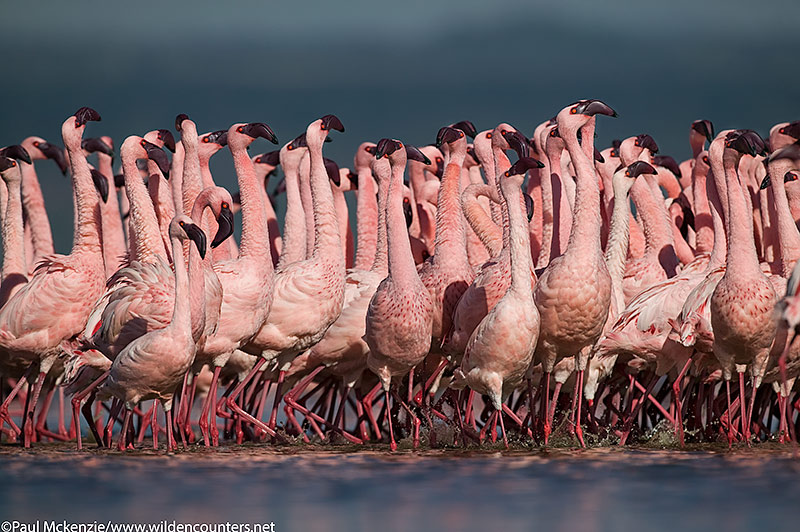
The courting birds can swell to several hundred. Moving in a highly synchronized fashion, it is a mesmerising spectacle. Lake Nakuru, Kenya
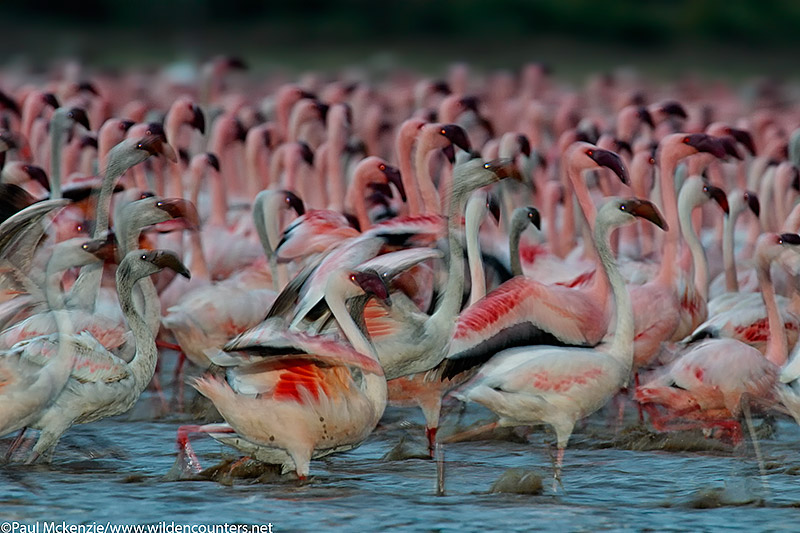
The dance rituals can occur at any time of the day. This is at dusk with the image taken using a slow shutter speed and flash. Lake Bogoria, Kenya
Lesser Flamingos are more numerous in East Africa than Greater Flamingos although the latter are much more widespread globally. The Greater Flamingos are larger, have more vivid wing colouration, have a pink versus a brown bill and are able to feed on small fish and crustaceans that have adapted to the lake environments. All in all, they are prettier and more photogenic.
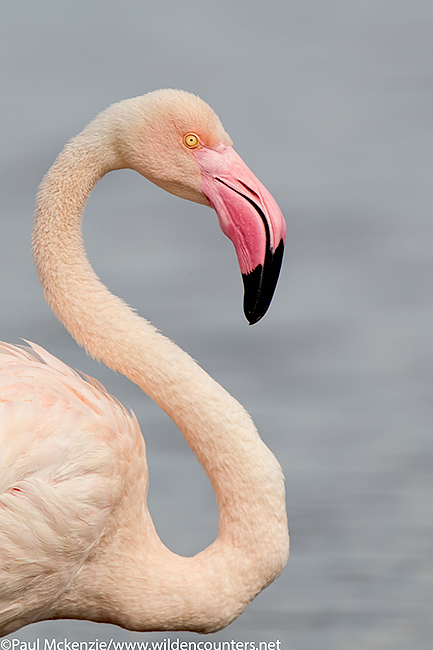
Greater Flamingo, Lake Magadi, Central Serengeti, Tanzania
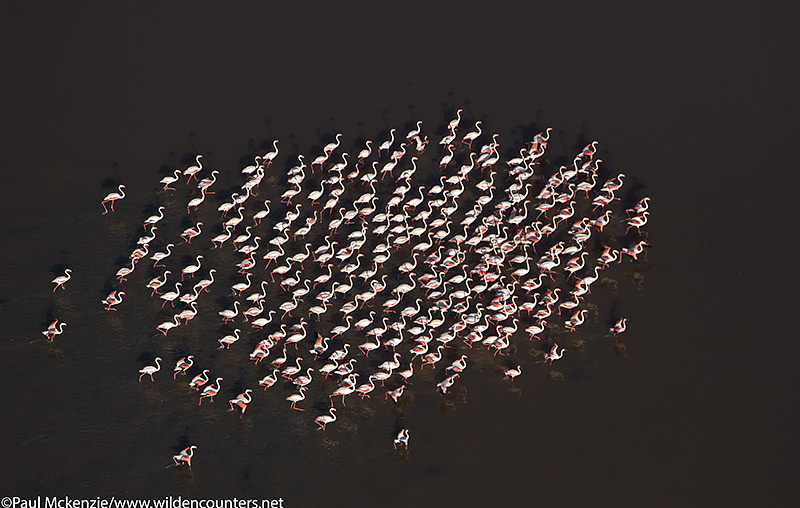
Aerial image of Greater Flamingos in late afternoon sunlight, walking through the shallow waters of Lake Natron, Tanzania
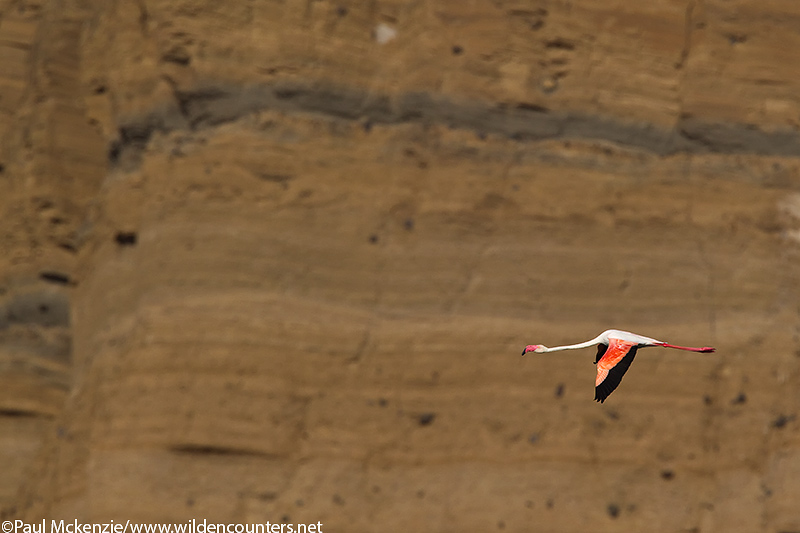
A solitary Greater Flamingo flys past the crater wall of Flamingo Crater Lake, Central Island, Lake Turkana
The soda lake environments continue to fascinate me. Harsh, beautiful and outer worldly are adjectives that cannot often be used in the same sentence but these sum up the lakes. However, it is their charismatic avian residents that complete the picture of wonder. How these birds have adapted to the severe conditions is a triumph of natural evolution. Viewed from the air, the lakes provide a visual overload that from my experience is unmatched on our planet. Like drugs, aerial photography is not a cheap addiction to have developed but I can take comfort that at the end of my life it will be these “highs” that will be amongst my most treasured experiences.
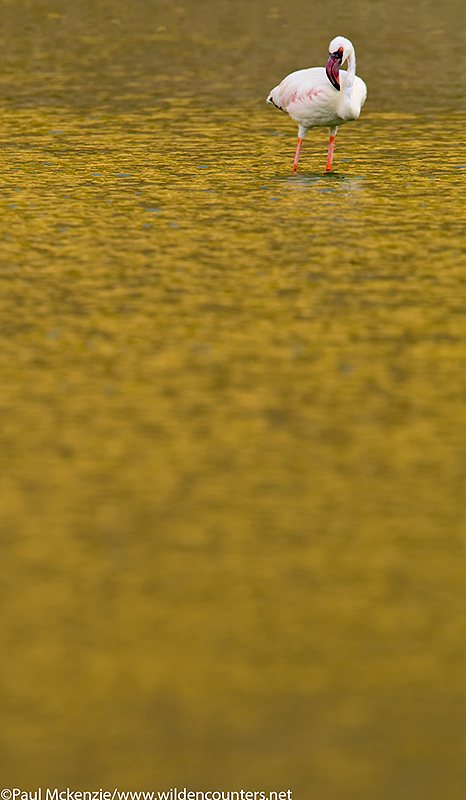
Juvenile Greater Flamingo standing in golden reflected water, Flamingo Crater Lake, Central Island, Lake Turkana, Kenya
Gordon Lindsay
December 13, 2014
Beautiful images Paul thanks for sharing them and I enjoyed the story behind the shots, how they were taken etc. I’m looking forward to the next instalment.
Paul Mckenzie
December 13, 2014
Thx so much Gordon. You are always so generous with your praise. Take care. Paul
Osvaldo Larrain L.
December 13, 2014
Hi Paul, long time no see, remember coming down here, lots to see and of course photographing. That is true of all these pictures that show us, each one is better than the other. This confirms to me that no matter what or reasons to photograph but the great artist behind camera.
A big hug and hope to see you soon.
Osvaldo Larrain L
photographer
http://www.osvaldolarrain.com
569 92309303
Paul Mckenzie
December 13, 2014
Thx Osvaldo. I will be coming through Santiago next October. Would love to do another day with the Aztec Terns down in Valparaso if you are around. Will stay in touch.
Osvaldo Larrain L.
December 14, 2014
Your home here, just let me know whatever you need or want to do some especial spot.
Cindy Walpole
December 13, 2014
all I can say is WOW, Paul! It was certainly worth the wait.
Paul Mckenzie
December 15, 2014
Thx Cindy – hopefully won’t be too long before the next blog.
Rodolfo Patron
December 13, 2014
Dear Paul!
Simple awesome images of a very photogenic bird, taken in very beautiful backgrounds selected by your artístic taste and with the unique composition talent that you have.
Lily and I will be traveling to Atacama in Chile with our family, with Bibiana and her family and other two families.
Regards from México and Happy Holidays!
Rodolfo
Paul Mckenzie
December 15, 2014
Hi Rodolfo. So good to hear from you. The Atacama is really special. You will love it. All the best to your family. Best regards, Paul
Verschueren Yan
December 14, 2014
Everytime you let us enjoy of your picture’s it’s worth to wait. real of the flamingo is top! Amazing beautifull!!! I hope to make an appointment in 2016 in Kenia. Very difficult to choise but y favorite’s are: aerial image of Lesser Flamingos flying over evaporating sodium compounds on the surface of Lake Natron, aerial image of thousands of Lesser Flamingos grouped tightly together, Lake Logipi,Lesser Flamingos on shallow water lake beside algae slick, aerial shot, Lake Logipi, and… and… and… never ending Best regards Yan
Paul Mckenzie
December 15, 2014
Hi Yan. I still remember our time in Japan fondly. Am headed back there next February. I am still very keen to do a Congo trip with you if you are going again with WWF. Stay in touch on this.
Ron Horn
December 14, 2014
Paul, your images continue to amaze me. They are outstanding. The green algae slicks remind me of the northern lights.
Paul Mckenzie
December 15, 2014
Hi Ron, have been enjoying your northern lights images over the last year. Hope all is well with you and the family. Have a great Xmas.
Tin Man Lee
December 14, 2014
Paul, once again, super blog post. The photos are awe inspiring and your story is a joy to read. I just smile and cry along with these magnificient animals and landscapes. You are right, it’s totally like a planet outside earth. Once I can travel to Africa please leave a seat for me on the plane. I don’t mind my face being in a wind tunnel.
Paul Mckenzie
December 15, 2014
The seat is waiting! let me know when you can travel.
Wim Kijne
December 14, 2014
Wondeful blog, thanks!
Paul Mckenzie
December 15, 2014
Thanks Wim for dropping by and commenting. Much appreciated.
Arthur Morris
December 14, 2014
Hey Paul, Thanks for the education and the breathtaking collection of images. Hard to pick even a dozen faves but “Evaporating mineral trails on the surface of Lake Natron beside a lake shore delta heavily encrusted with sodium and phosphate compounds” and “Greetings” are right up there…. Posted from the Albatross Hotel in Ushuaia 🙂 Had some great pork and smashed pumpkin for dinner.
Paul Mckenzie
December 15, 2014
Yes, the Albatross hotel. Will be there next year. So jealous of your trip. Am sure it will be great.
Jaime Migoya
December 16, 2014
Hi Paul.
Your images are stunning and the descriptions are a joy to read. I am sending the link to my brother who works protecting the flamingos in the yucatan península.
Jaime Migoya
Paul Mckenzie
December 16, 2014
Hi Jaime,
I am very interested in going to photograph the Flamingos in the Yucatan. Could you send me your brother’s contact details and maybe send him a brief e-mail that I will be contacting him. Many thx, Paul
Christian Strebel
December 18, 2014
Paul;
great collection and summary of all those flights!
Many thanks for your trust in our abilities!
Merry Christmas and a successful 2015 to all of you from Nairobi
Paul Mckenzie
December 29, 2014
Thx Christian. Couldn’t have done any of this without you!
Clemens Vanderwerf
December 27, 2014
Great story and images Paul. It is amazing what nature can do over time and the art it produces. Very well captured and I am looking forward to the coffee table book about your experiences with this beautiful landscape. Love the flamingo images.
Best and Happy New Year,
Clemens
Paul Mckenzie
December 29, 2014
Thx Clemens. Looking forward to our South Georgia trip together.
Nilla Stennes
January 7, 2015
Paul,
you are opening up a whole new world for us !
What a privilege to see Mother Nature through your eyes.
Janie Greene
November 23, 2015
Thank you Paul for sharing your stunning photographs! I especially loved your arieal views of the flamingos in Kenya and Tansaznia I was in the Kenya and T. 3 times and wished I could be in a plane photographing those beautiful creatures from above. But now that I’ve read your article…I have a second thought. Your experience is more than I have the courage for… I’ll just enjoy your gorgeous images. Thank you, thank you …your gift of photography is great. Janie Greene
yan Verschueren
November 30, 2015
Hi Paul,
Still I’m impressed. Many times I look to this fantastic pictures. I can’t get enough of this magic. It’s so difficult to choose the most exceptional one They are all superb. Maybe for me I choose Aerial image of thousands of Lesser Flamingos grouped tightly together, Lake Logipi, Kenya Thnaks for to let enjoying me your adventure
Many greetings Yan